After I had extensively enjoyed the fine view from the Minster Terrace in Bern, I went to a nearby street Junkerngasse. The main reason why I went to this street is that it is the best preserved street in the city and it has once also been described as the “most magnificent cityscape in Europe” on account of the big buildings that are here and the back parts of which have a view at the Aare river and have open terraces and gardens. Because of all of this, I am going to repeat the last photograph from the previous sequel of my travel stories, since it shows precisely the back facades of these buildings and their gardens and terraces.
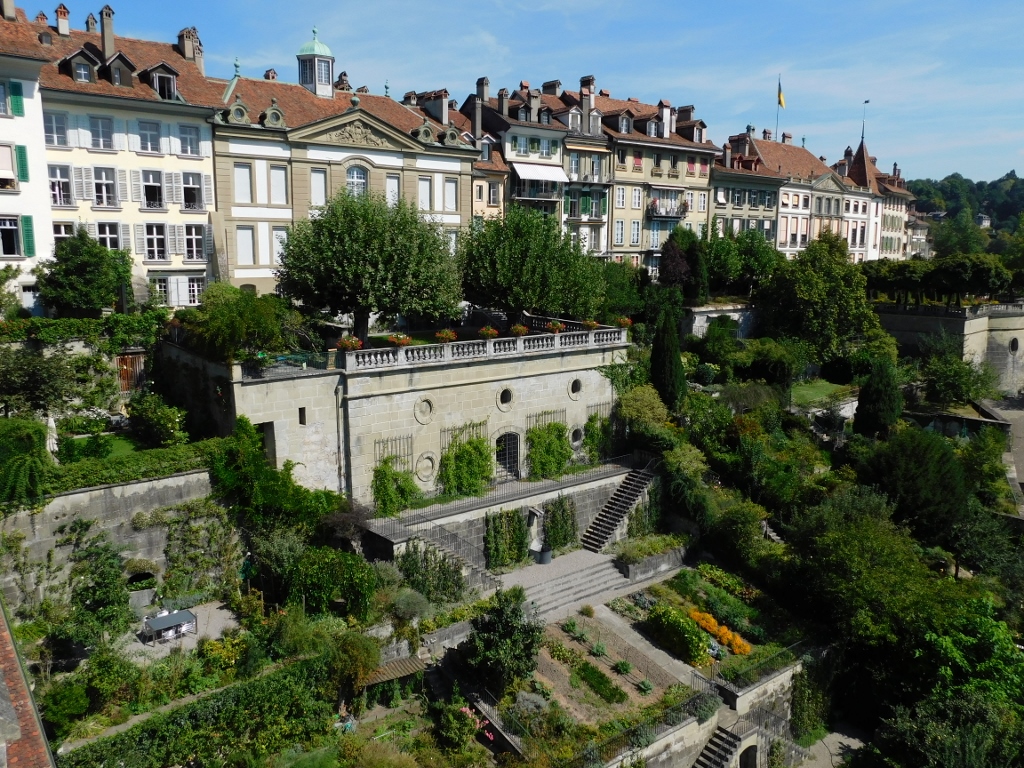 Parts of the buildings from Junkerngasse facing the Aare river
Parts of the buildings from Junkerngasse facing the Aare river
Although Junkerngasse is significantly quieter street in comparison to the main one, without shops and intensive traffic, here, too, there are arcades for the passage of pedestrians.
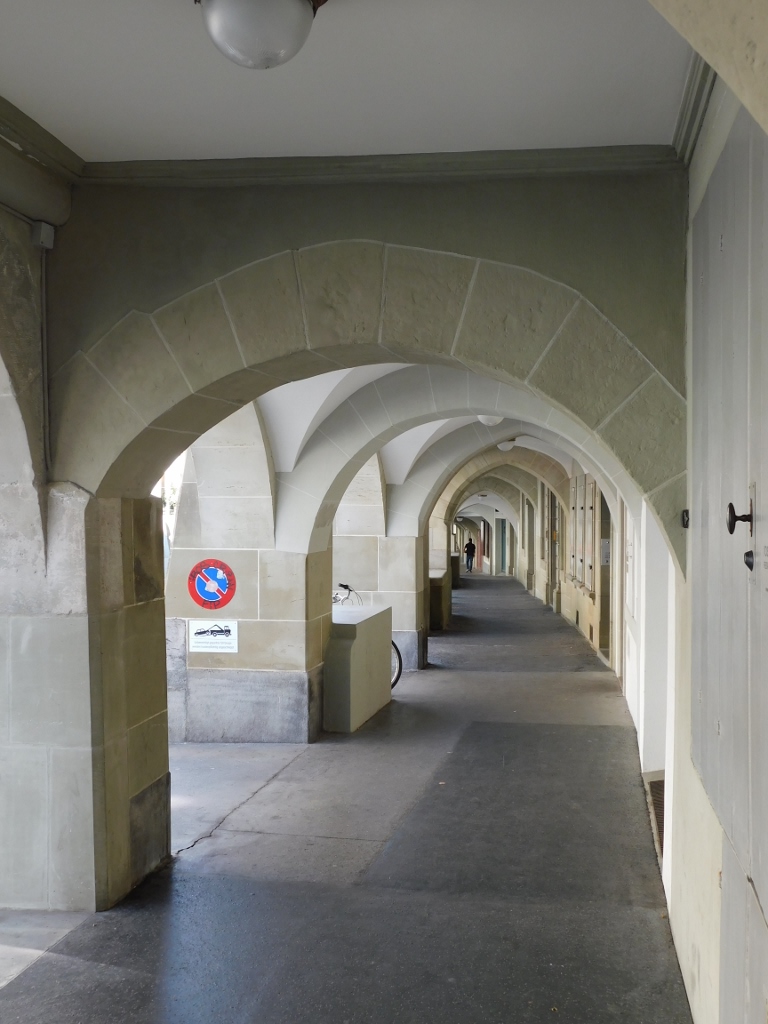 Arcades in the quiet part of Bern
Arcades in the quiet part of Bern
The appearance of the street itself, these arcades and the facades of the buildings seem rather modest and subdued, and nothing suggests the dramatic visual situation on the side of the buildings facing the river. Still, there is one building that stands out to a certain degree with its front facade and that is the building at no. 47 which nowadays houses the city council and the mayor’s office. It was built in 1748 as a private town residence and since 1821 it has been owned by the City of Bern, hence its present-day function. By its characteristics, the building is one of the most prominent in the Old City and is a part of the historically important structures which, among other things, make Bern inscribed in the UNESCO’s World Heritage List.
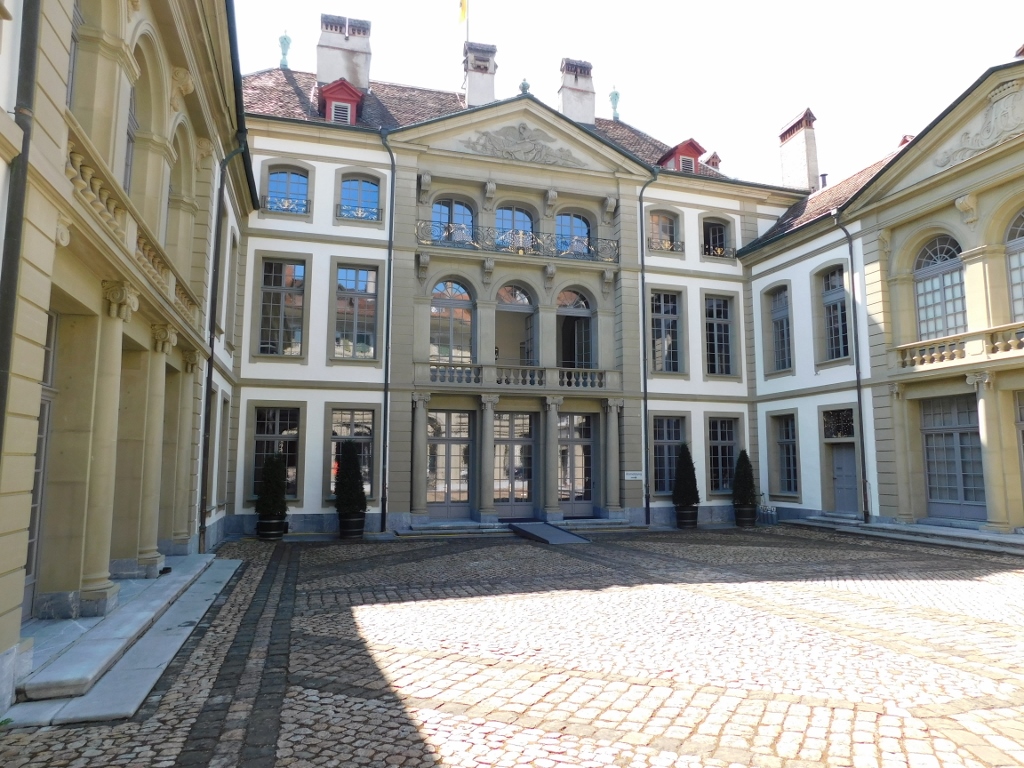 Building at Junkerngasse 47
Building at Junkerngasse 47
In the same street, at numbers 17, 19 and 21, there are three buildings from the beginning of the 18th century that are very important in construction terms and for the history of Bern. The materials I used mention the shapes of the windows, the influence of early Baroque, the general elegance and elements that clearly suggest patrician affiliation of the owners. Although I looked at all three very carefully, I could not see anything particularly interesting there. It is certainly necessary for the visitor to have significantly better knowledge of architecture and its history than I in order to be able to appreciate them fully. Here is a photo of one of these buildings (no. 21).
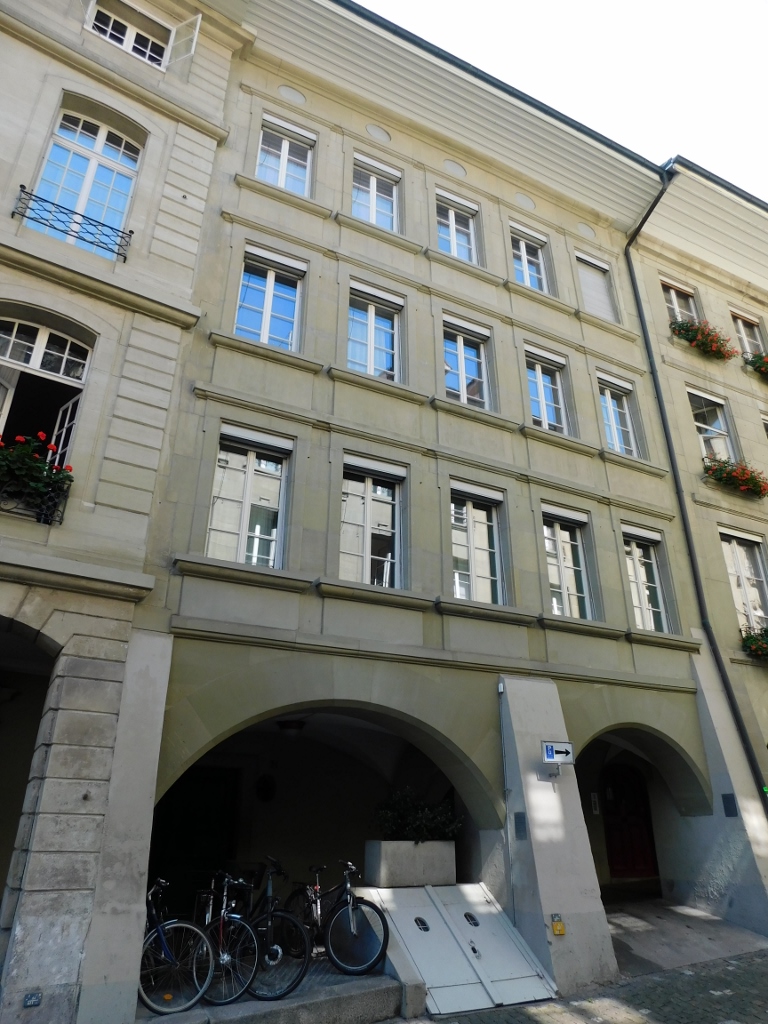 Building at Junkerngasse 21
Building at Junkerngasse 21
On the other side of the street, at number 22, there is also a lower house, but it has a livelier facade that was done in 1913.
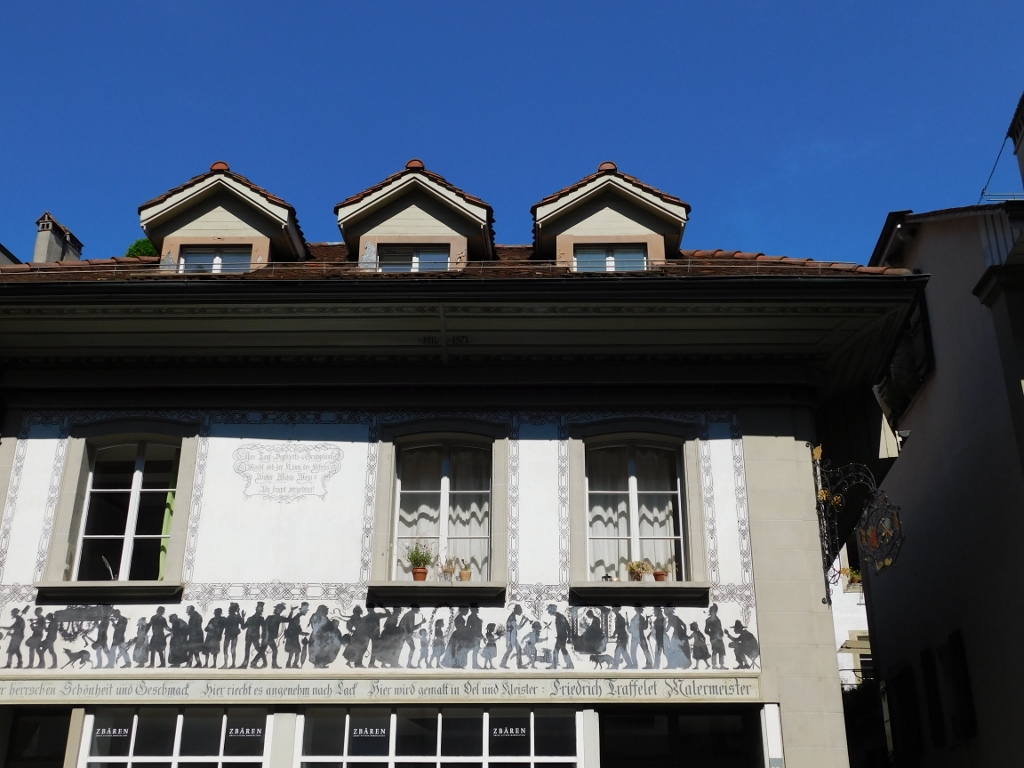 Building at Junkerngasse 22
Building at Junkerngasse 22
These buildings that I have mentioned here are not the only ones in this street that are considered important, but this is some choice of mine.
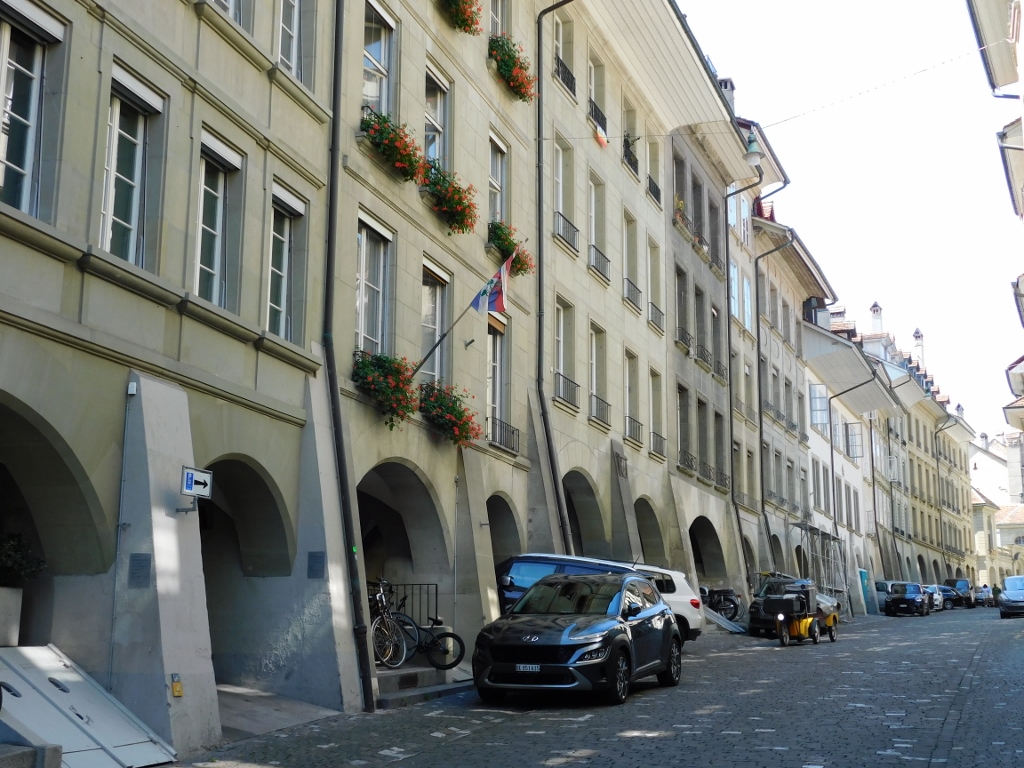 Junkerngasse street
Junkerngasse street
It is also mentioned that there is a drinking fountain in the street, although at the end of the street I saw another one as well that was linked to a house, but I found its simplicity quite attractive.
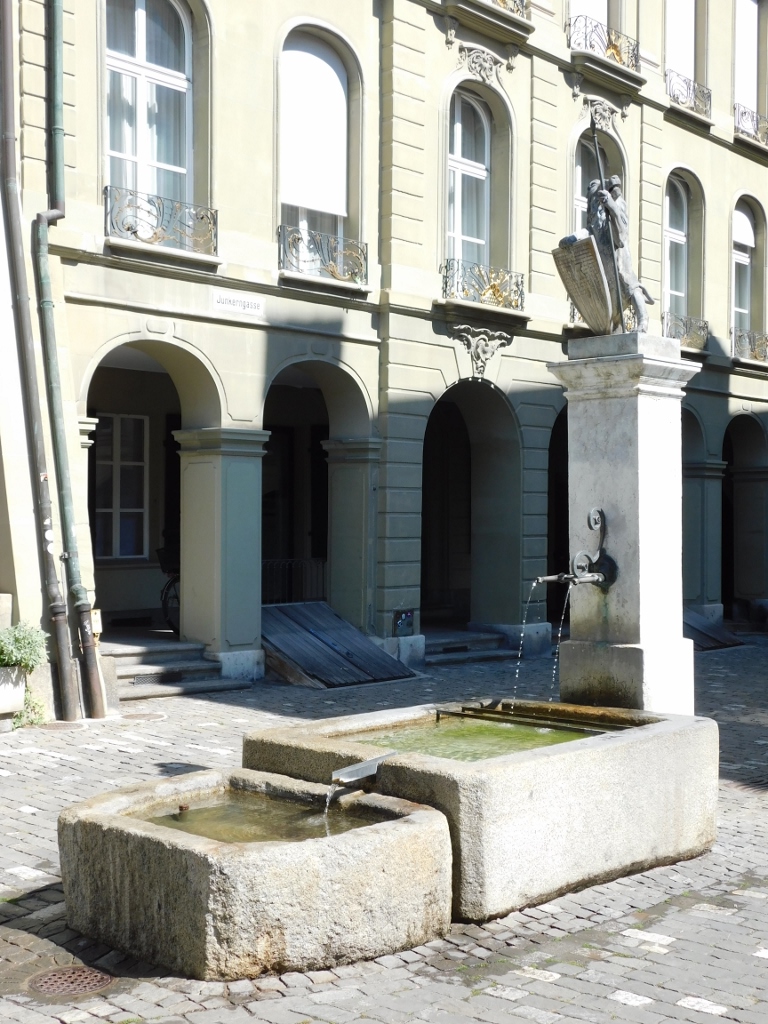 Junkerngassbrunnen fountain
Junkerngassbrunnen fountain
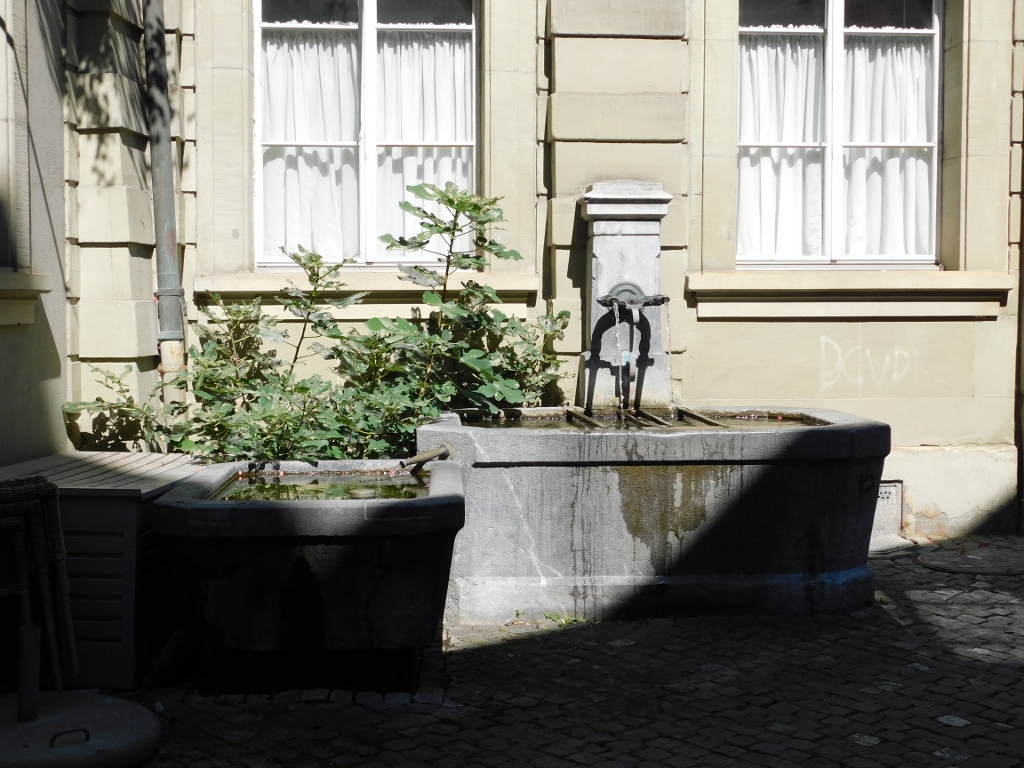 No-name fountain
No-name fountain
And so I came to a section where the main street, which by the way has meanwhile changed its name again, descends from the centre of Bern and turns into Nydeggasse street that further leads towards the Nydeggbrücke bridge.
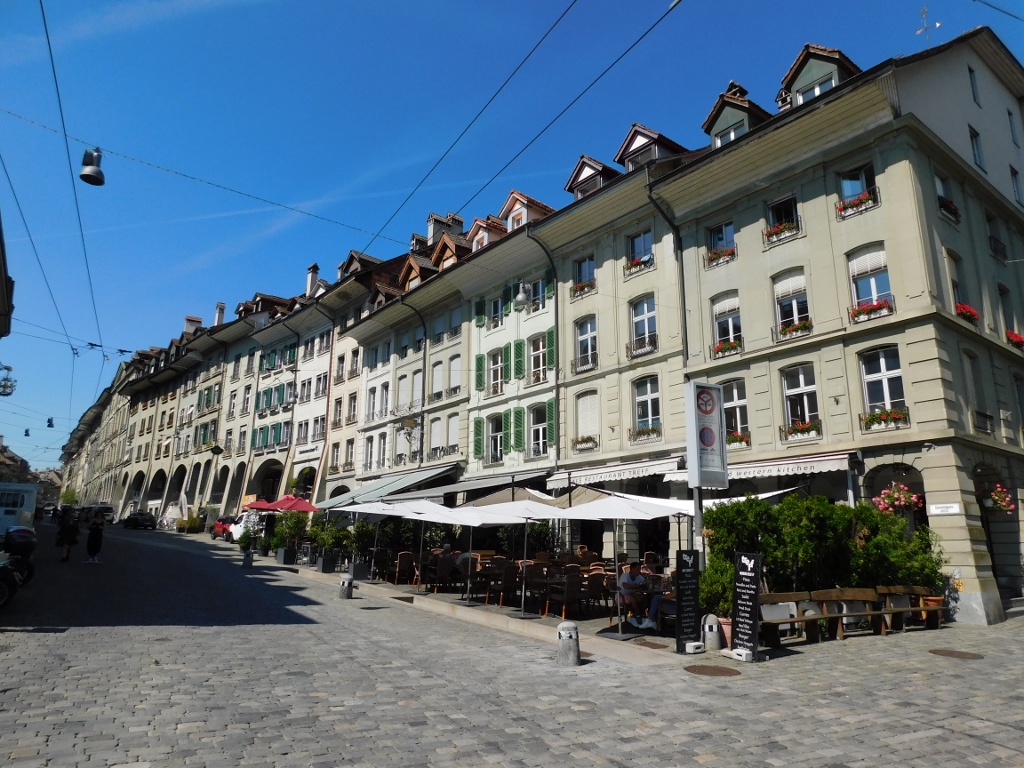 Gerechtigkeitsgasse
Gerechtigkeitsgasse
Still, before getting to the bridge, one can also see Nydeggkirche church.
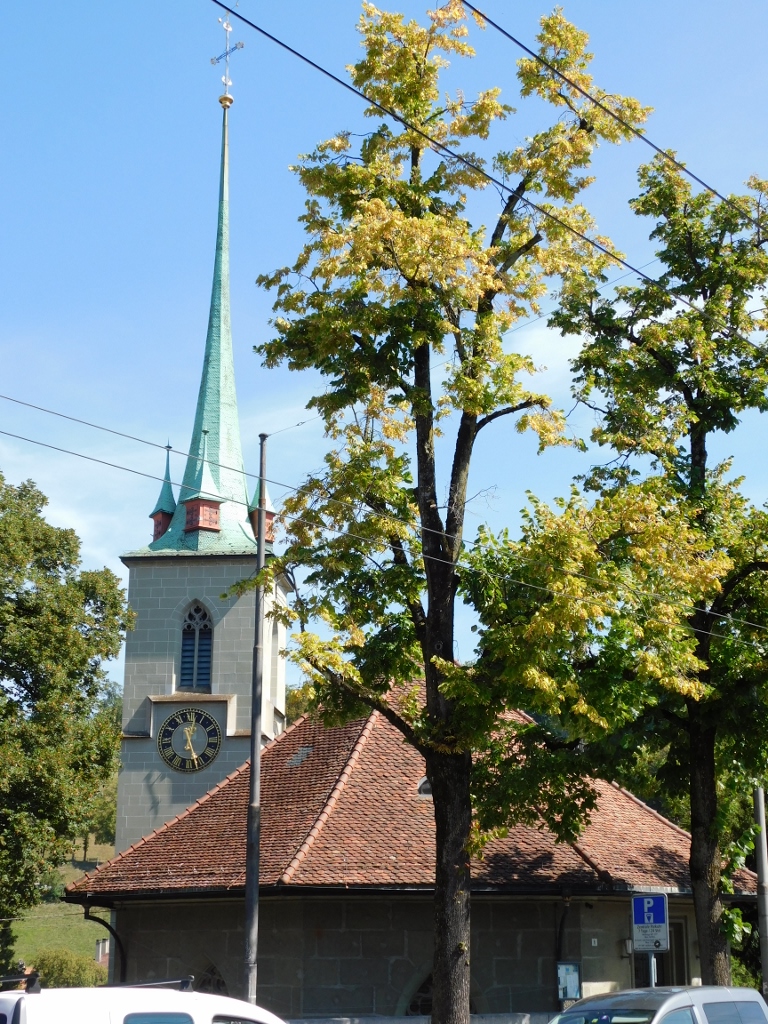 Nydeggkirche
Nydeggkirche
This is the area where there is the oldest inhabited section of Bern that originally developed at the end of the 12th century. The first church in this place was built around the middle of the 14th century and this was at the site where previously there used to be the Nydegg castle built by the founder of Bern. The church has undergone various phases, reconstructions, additions, modifications, etc, only to be fully restored around the middle of the 20th century. It was then that some bronze reliefs were placed within the church that are nowadays emphasised quite a lot, but I did not plan to go to the church, opting to go directly to the bridge instead.
The reason was simple: an exceptionally beautiful view.
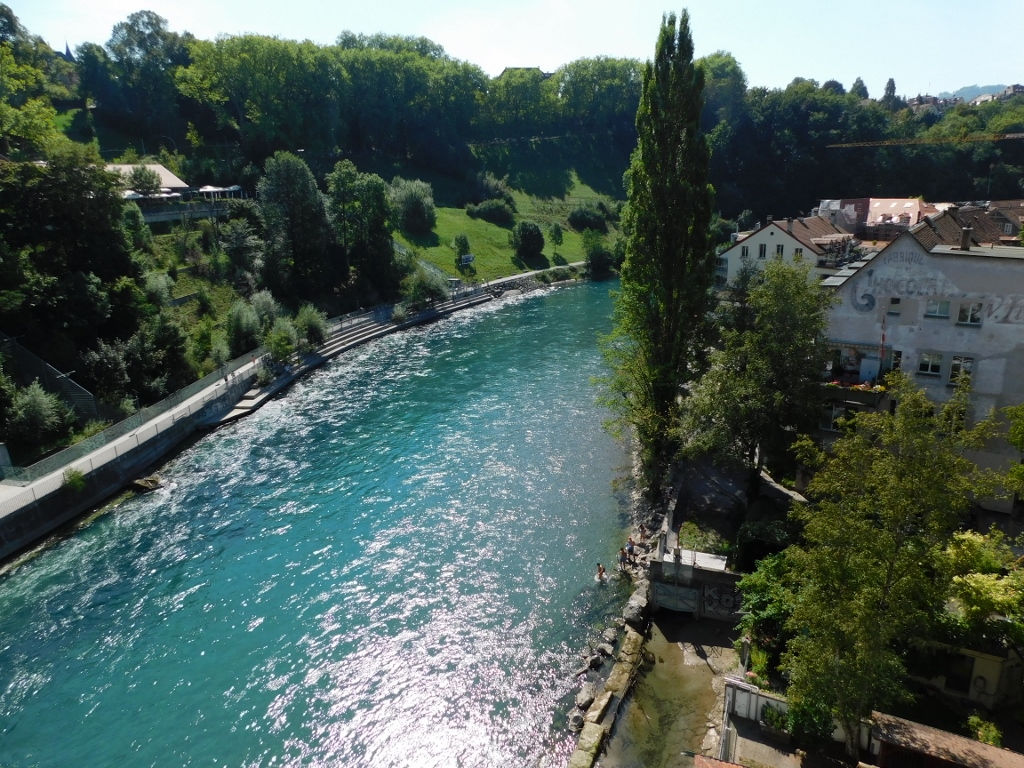 View at the Aare river from the Nydeggbrücke
View at the Aare river from the Nydeggbrücke
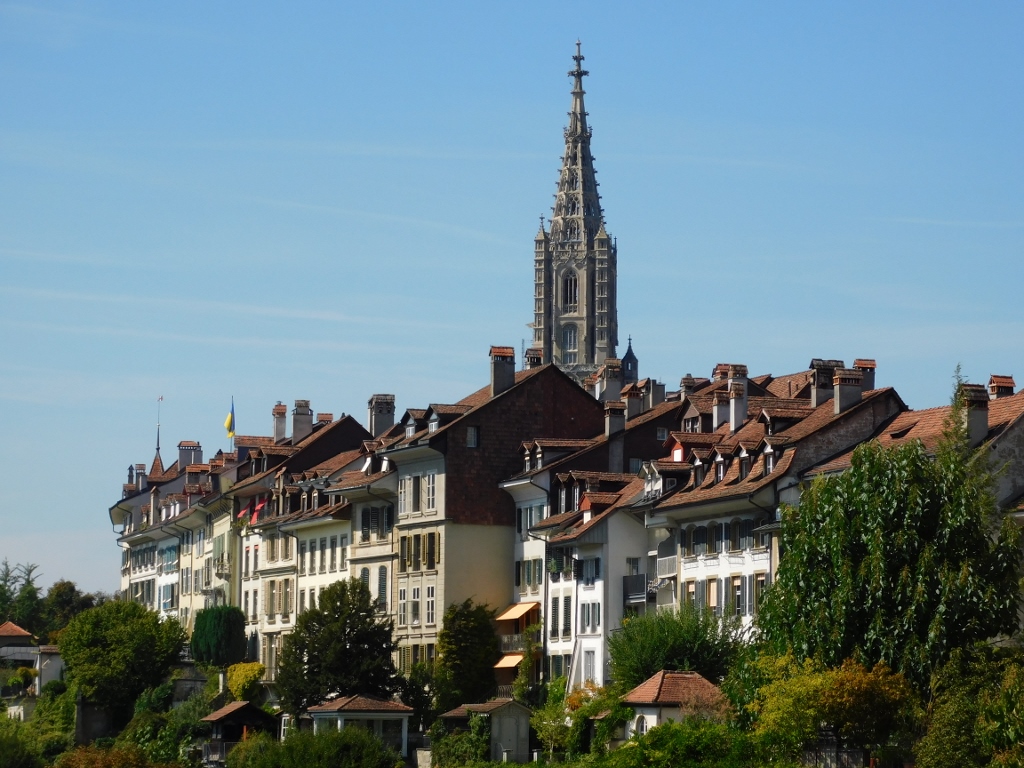 View at a part of Bern with the Cathedral from the Nydeggbrücke
View at a part of Bern with the Cathedral from the Nydeggbrücke
 View from the Nydeggbrücke
View from the Nydeggbrücke
When I crossed the bridge, I paid more attention to the Aare river and south parts of Bern once again, but I also noticed something happening in the river itself. These were some swimmers.
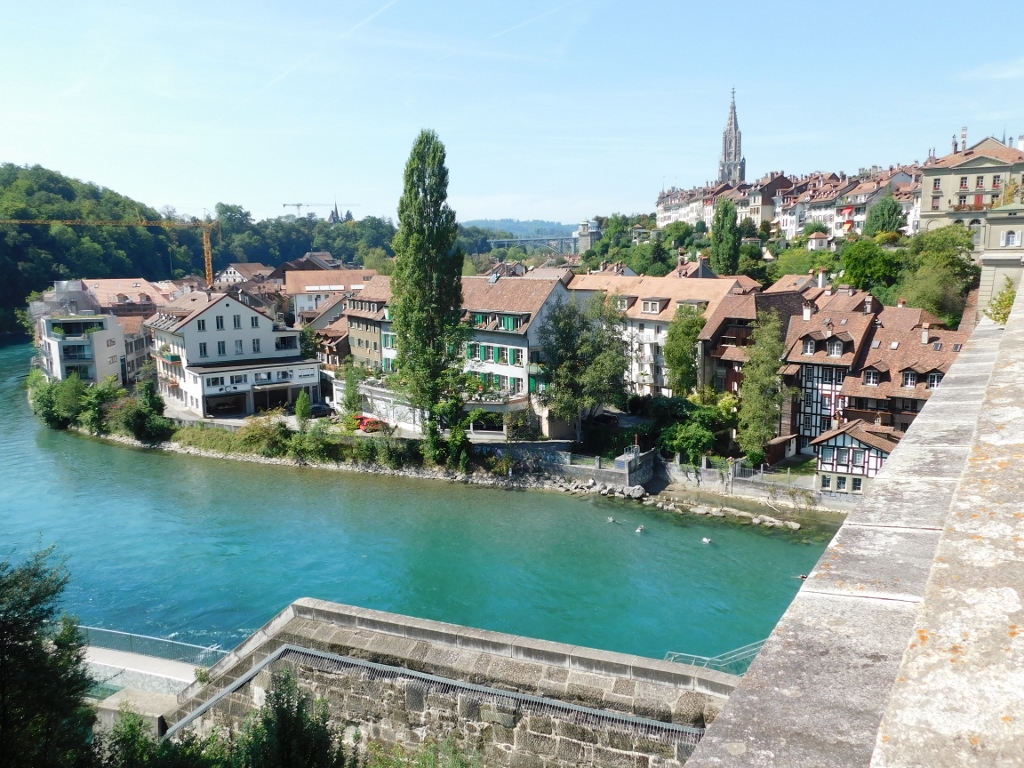 View from the Nydeggbrücke
View from the Nydeggbrücke
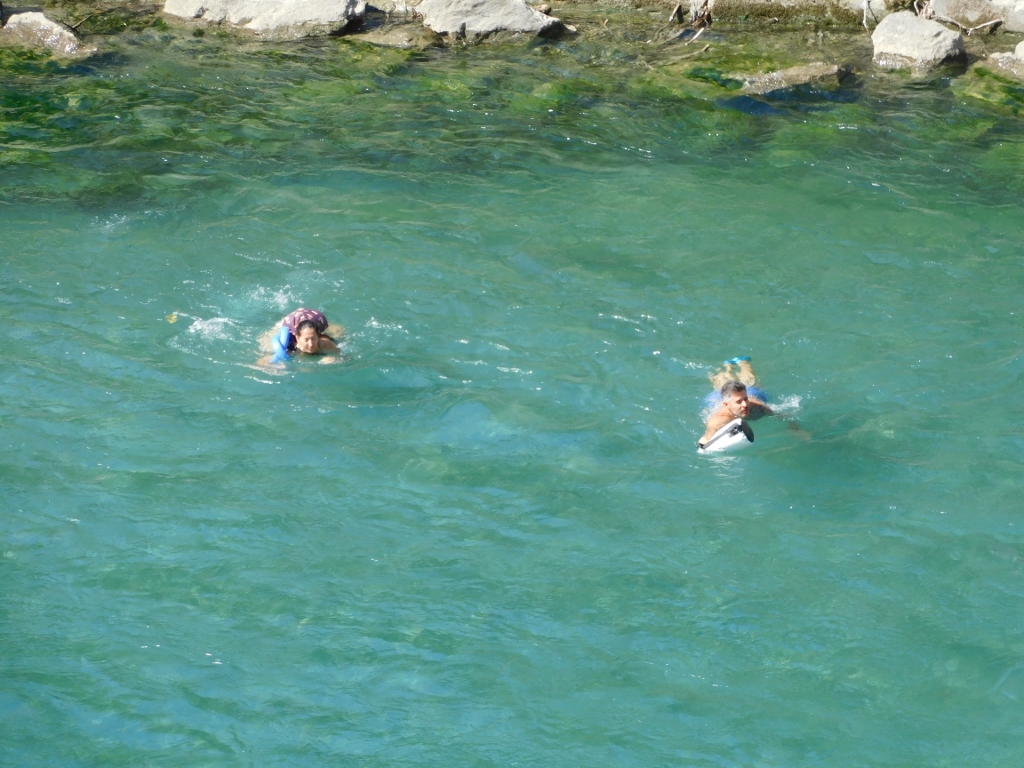 Swimming in the river in Bern
Swimming in the river in Bern
By the way, the first high-level bridge was constructed here around the middle of the 19th century so that people would no longer have to descend steeply down to the river and the old bridge. That low-level bridge still exists and can be seen on the other side.
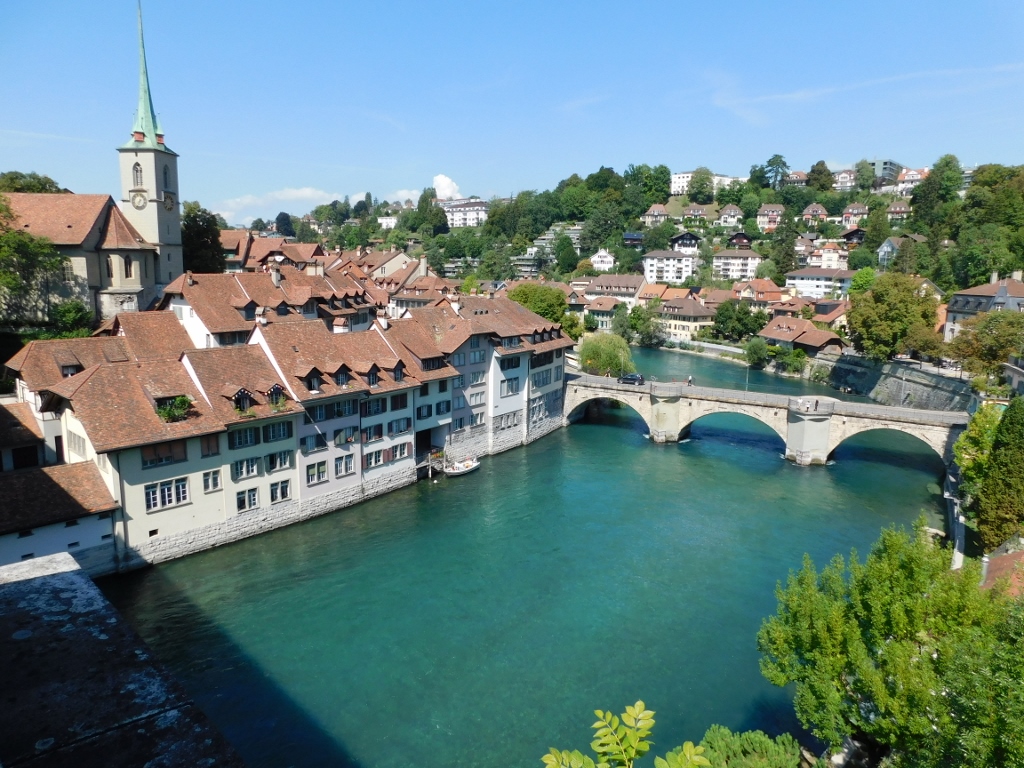 The Untertorbrücke bridge, to the right
The Untertorbrücke bridge, to the right
Still, the main reason why I walked this bridge, in addition to the stunning view, was to get to the Bear Pit (Bärengraben). I have already mentioned the legend about the founding of Bern and the first written documents that mention the keeping of a bear in the city date back to 1513.
Once you passed the Nydeggbrücke you get to a park with a famous Bear Pit. If you look attentively, you may even discern a bear or two.
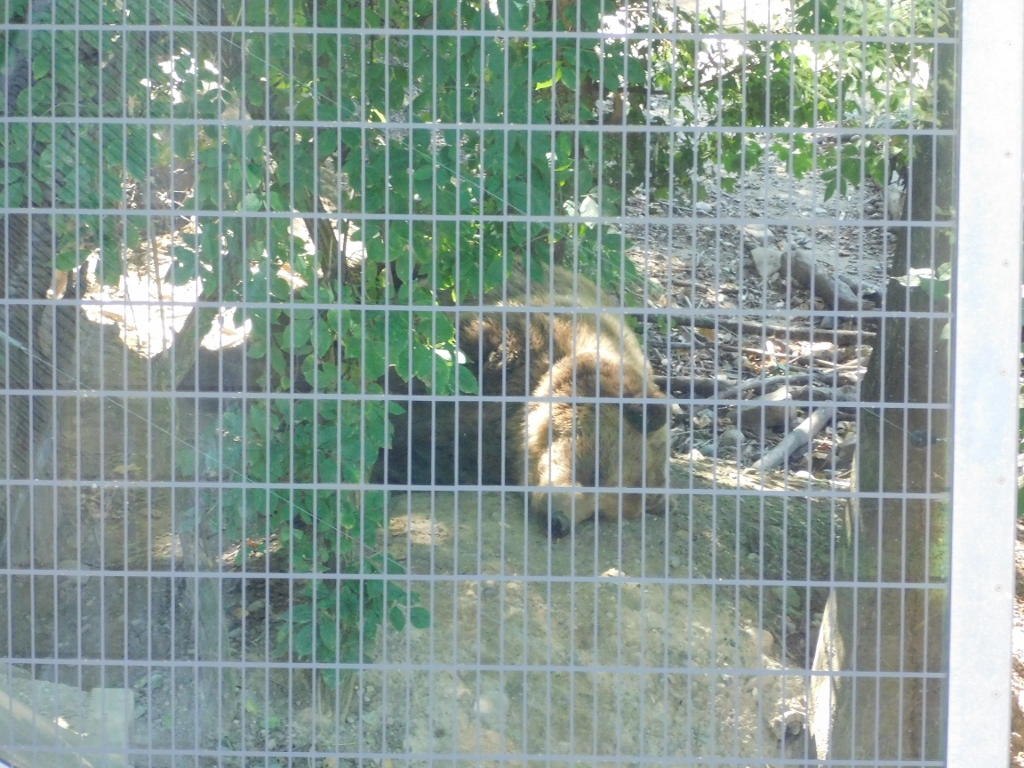 A bear in the pit
A bear in the pit
By now it was the time for me to start walking back towards the railway station, but at first I followed a different road in order to look at some other parts of the Old City. And so, at some point I walked along something that is officially deemed a street, but rather in reality looks like an underground passage.
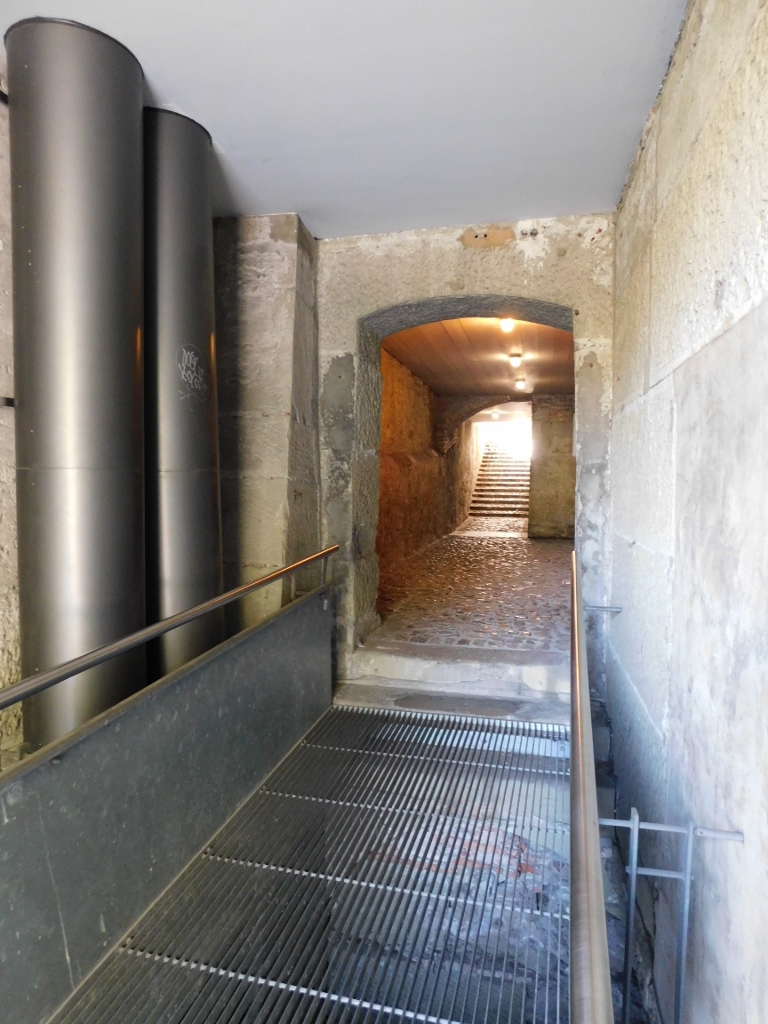 Is it a street or an underground passage?
Is it a street or an underground passage?
And then I reached the Postgasse street. To start with, I saw some flags on one of the buildings – in addition to that of Switzerland, there was also a flag of Bern (this refers both to the city itself and to the canton of the same name). Needless to say, it was with a bear image.
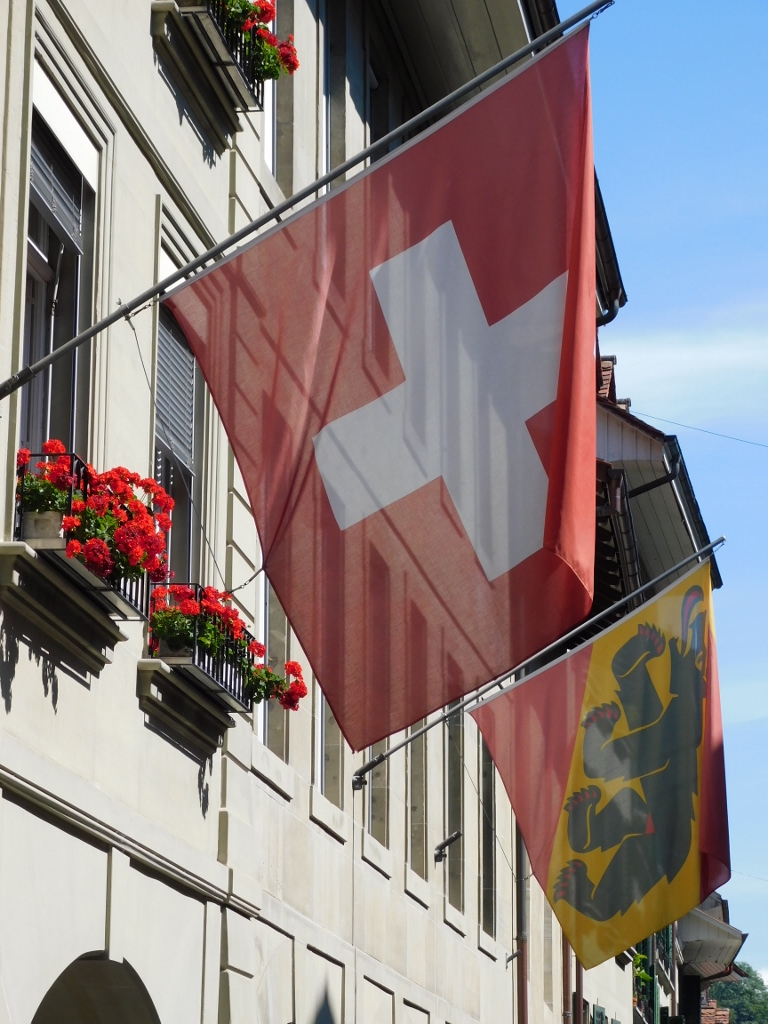 Flags in Bern, Switzerland
Flags in Bern, Switzerland
There were also public fountains again. The one that I walked by was the non-figurative Crown Fountain (Kronenbrunnen) from the first half of the 19th century with iron steps as an artistic addition from 1992, while another was again one of the historic drinking fountains from the 16th century – Vennerbrunnen. To reiterate – all of these drinking fountains offer for free very good quality water that can be drunk at will.
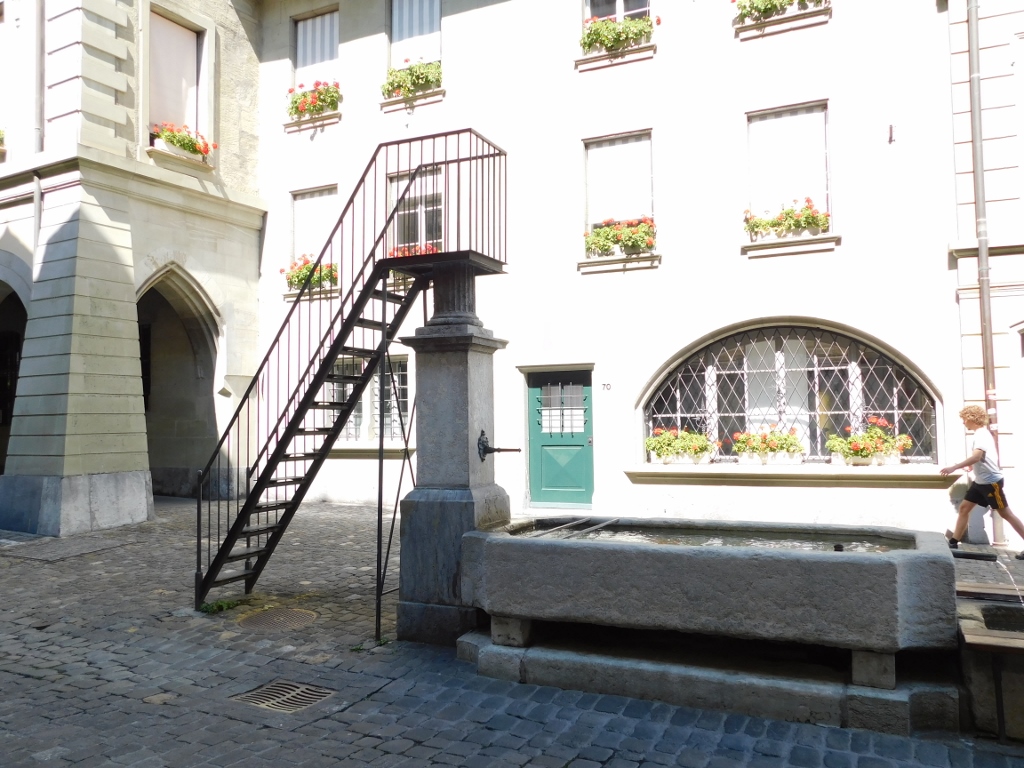 Kronenbrunnen
Kronenbrunnen
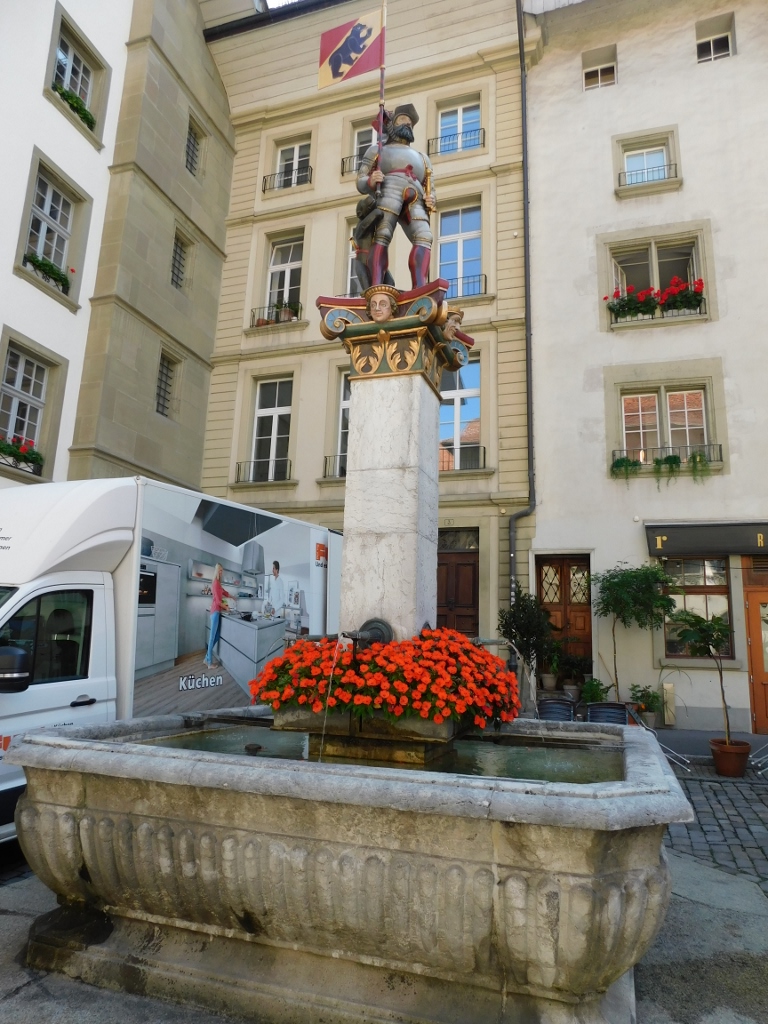 Vennerbrunnen
Vennerbrunnen
The reason why I came to this part of Bern was to look at the Town Hall that to this very day remains the political centre of the city and the entire canton of Bern, and which is located in the same square as the Vennerbrunnen. The edifice was built in the period 1406-1415.
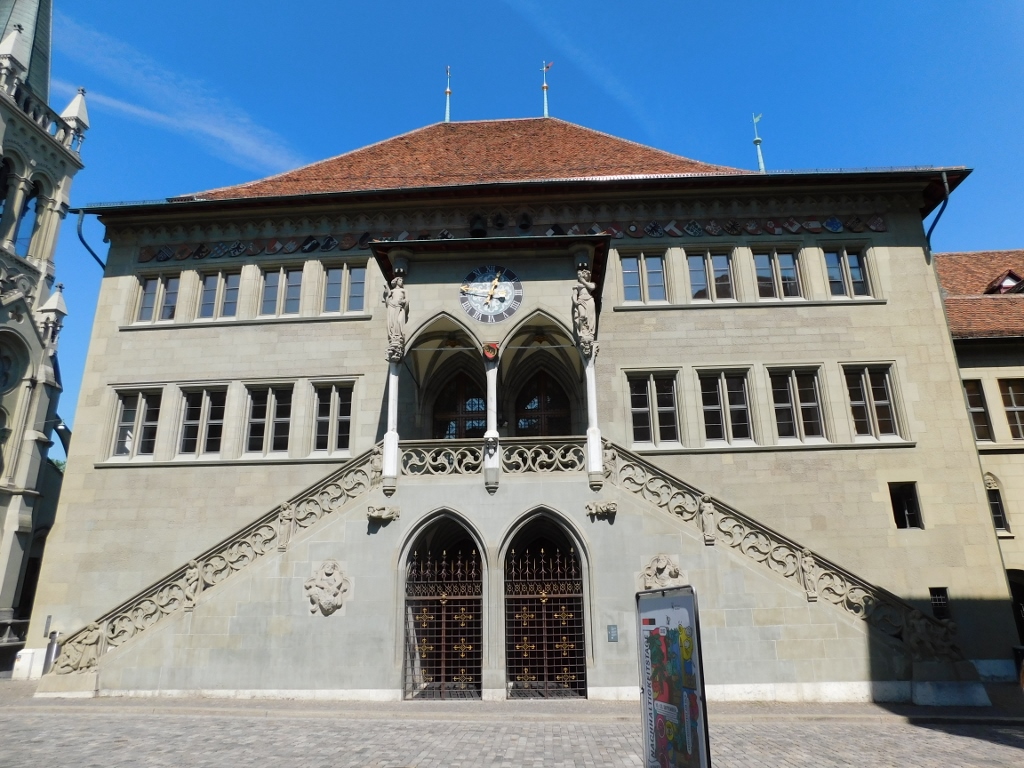 Bern Town Hall
Bern Town Hall
Directly close to the town hall, there is also the catholic Church of Sts. Peter and Paul (Kirche St. Peter und Paul).
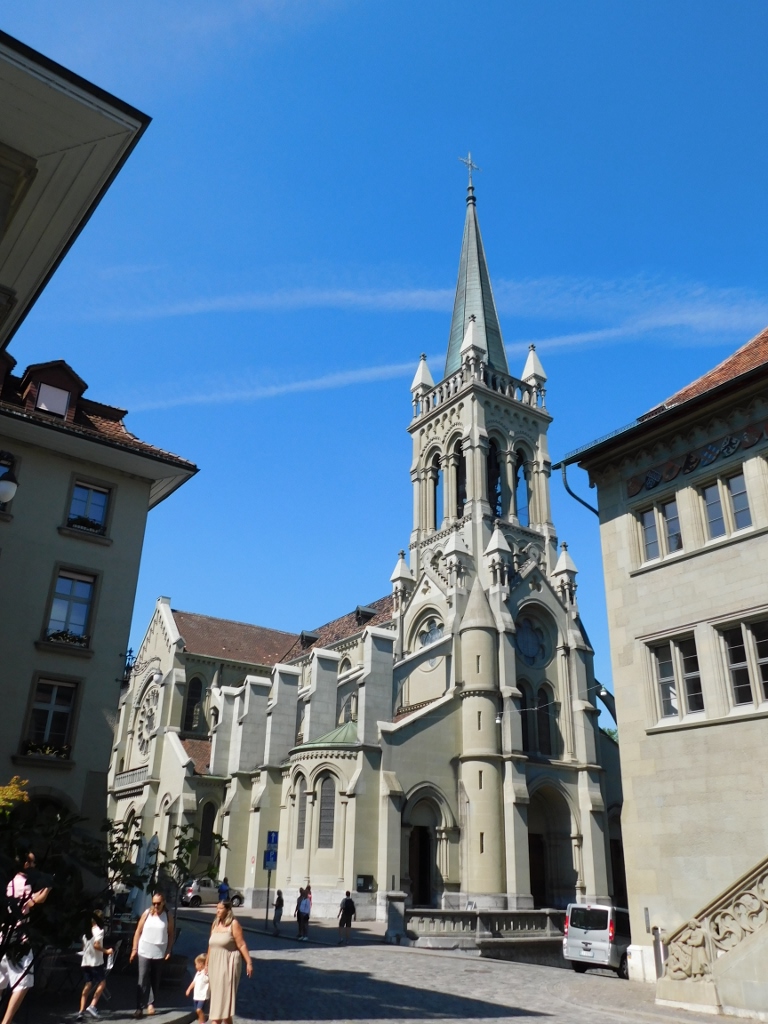 Church of Sts. Peter and Paul; the Town Hall can be seen to the right
Church of Sts. Peter and Paul; the Town Hall can be seen to the right
At the beginning of the 16th century, within the scope of the Protestant Reformation, the city of Bern converted to the new Protestant faith, while the Catholics who lived in the city remained without a church. It continued in this way until 1858 when the construction of the first catholic church in the city since the Reformation started. The church was completed in 1864 and the first mass took place in the church that same year.
Now I returned to the main street and headed again towards the Zytglogge tower. To start with, I walked past yet another fountain – the Kreuzgassbrunnen, named like that after a side street that intersects with the main one here.
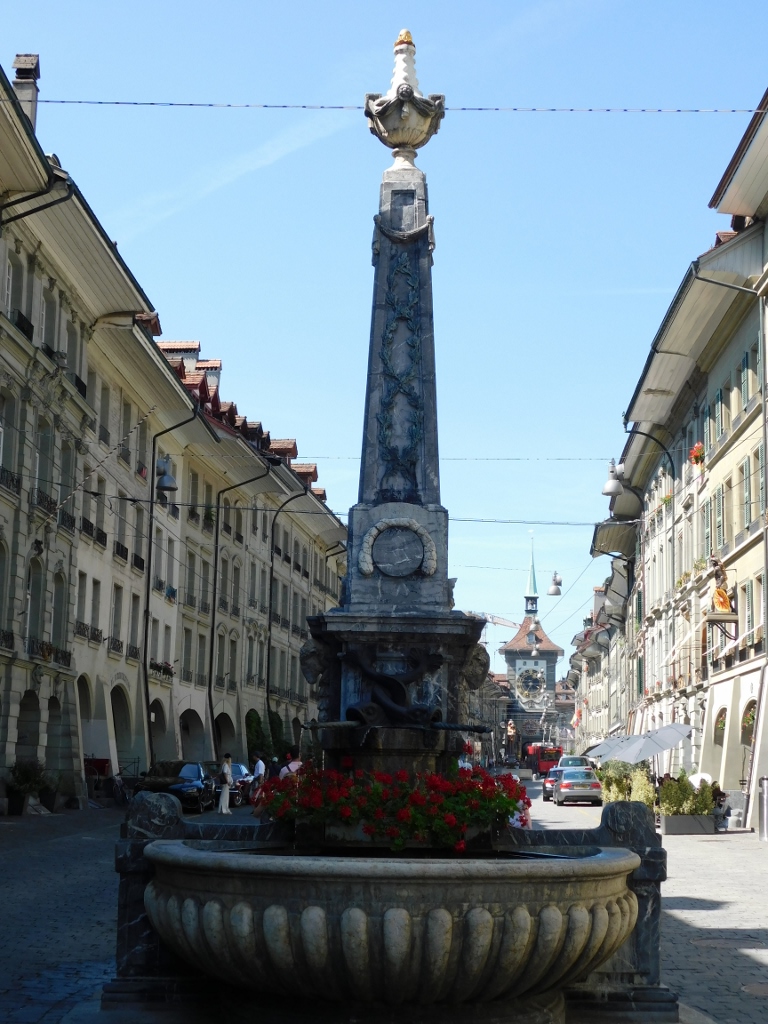 Kreuzgassbrunnen in Kramgasse street
Kreuzgassbrunnen in Kramgasse street
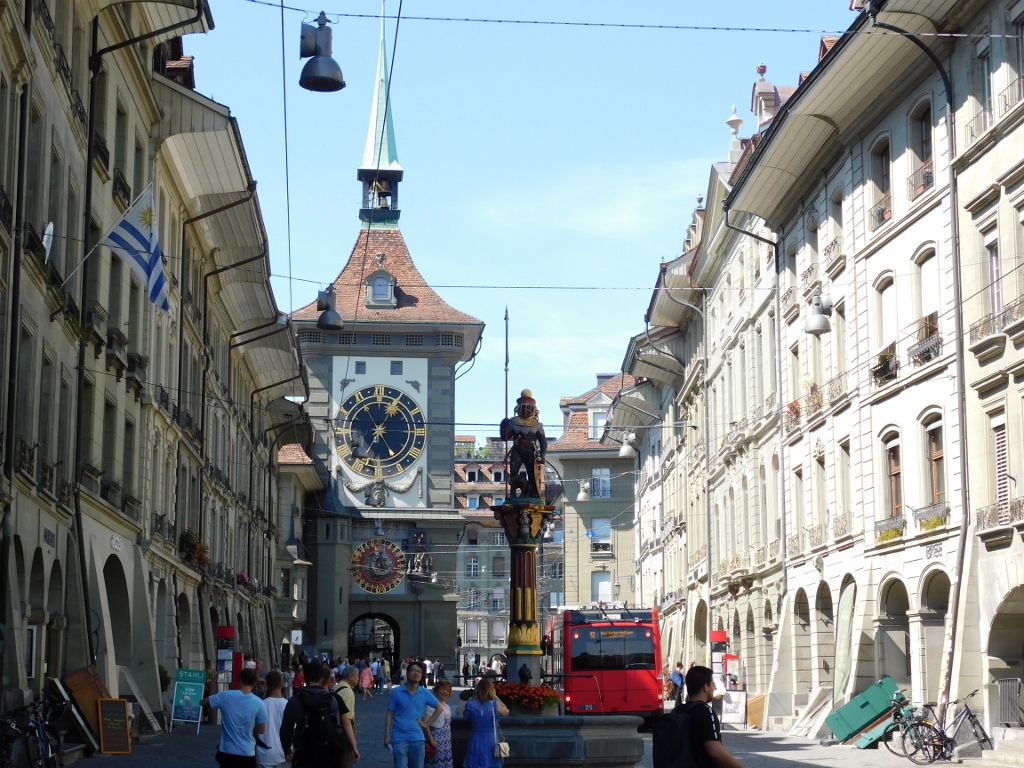 Kramgasse street and the Zytglogge tower
Kramgasse street and the Zytglogge tower
The Zytglogge tower was built around 1218-1220 and at the time it was used as a gateway within the west ramparts of the city. Over time the city expanded from the east parts that rise above the river in the westbound direction and thus there were three rows of ramparts with gateways that led into the city and this was the first row. The ramparts are long gone, while the tower had some additions, but was also destroyed in a fire, restored, expanded, modified, etc., Today it can be said that this is a medieval structure with the exterior done in the Baroque style with elements of the Gothic. The function of the tower also changed over time: it served to station city guards, as a gaol and clock-tower, while today it is primarily a monument of culture.
As the fate would have it, I reached the tower that also serves as a clock-tower just before 1 pm. There were already quite a few people standing there and then we all waited for the different parts of the clock mechanism to start moving and hit the bells. My advice: don’t do this at 1 pm. It all too short and by the time you realise which part is hitting at the given point in time, it had already stopped. Go to this clock-tower at noon. It must be much more interesting at that time of the day, provided you are into clocks and the movements of the mechanisms on this tower.
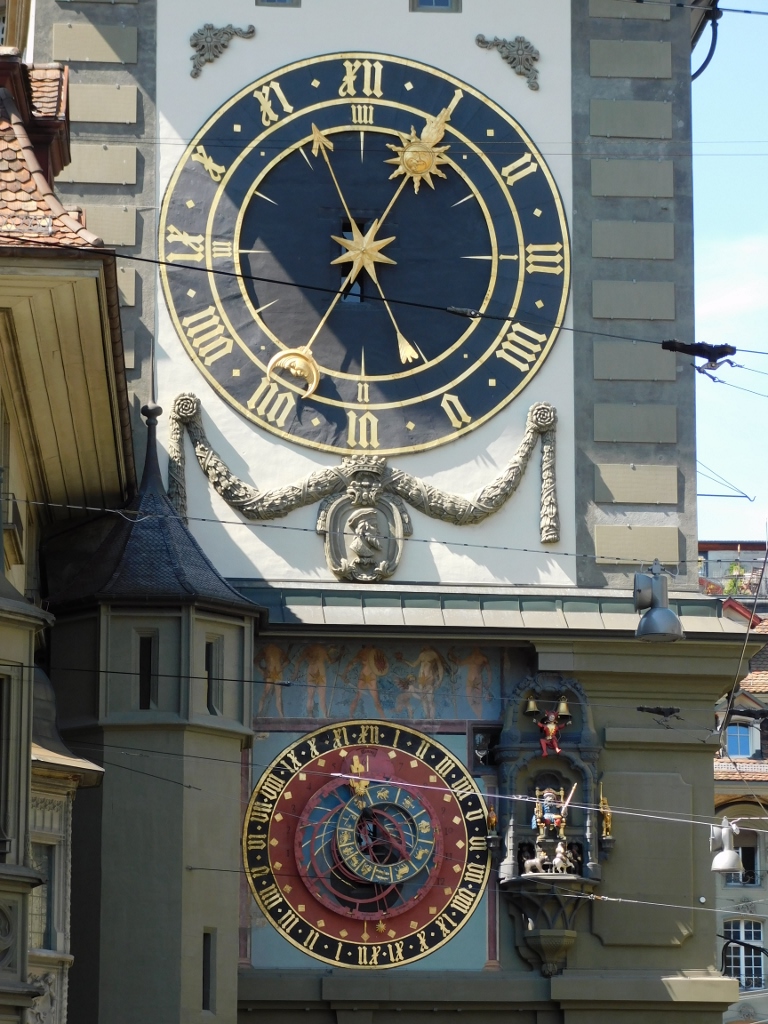 Zytglogge tower, a detail
Zytglogge tower, a detail
And so I finished with my formal visit to Bern here and only had to walk briskly back to the railway station and take the next train heading for Basel. From time to time I could see some nice sights from the train.
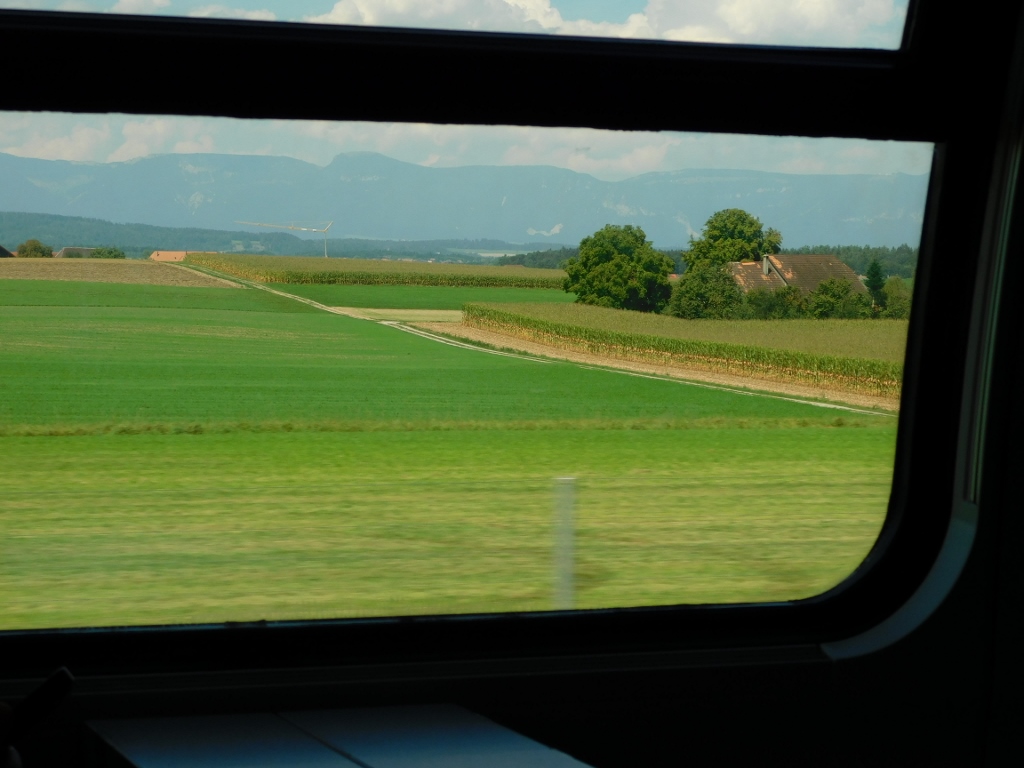 View from the train on the Bern-Basel line
View from the train on the Bern-Basel line
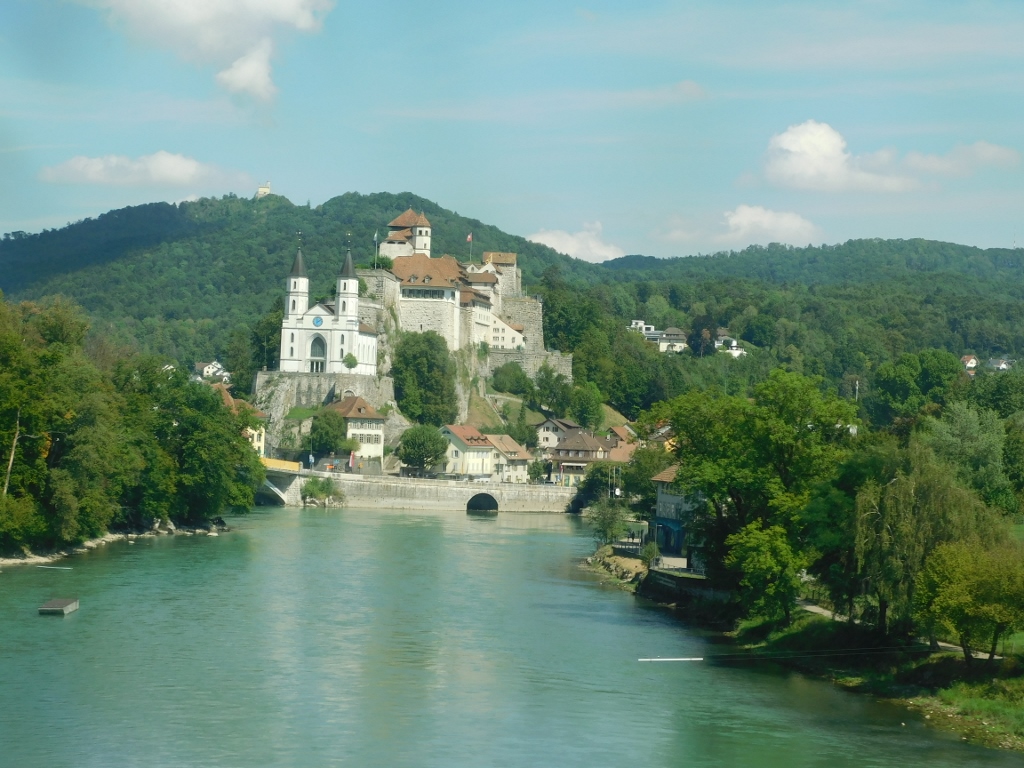 View from the train on the Bern-Basel line (the city of Aarburg)
View from the train on the Bern-Basel line (the city of Aarburg)
As opposed to Bern where the railway station is practically right beside the Old City, the situation in Basel is somewhat different and the visitor needs to get ready for some walking just to get to the more interesting part of the city. Nothing dramatic, but one should bear this in mind. Of course, you can always take public transport.
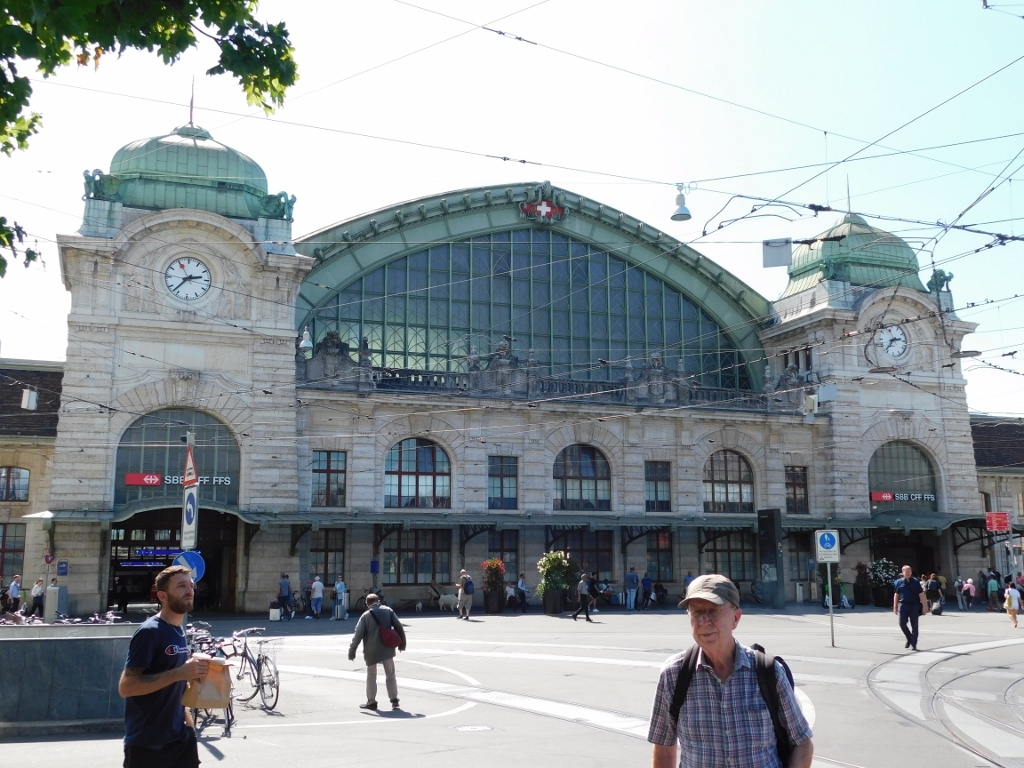 Railway station in Basel
Railway station in Basel
I thought it would be best to go to the Fine Arts Museum Basel first hoping it would be open, as it was Monday. I must say that the possibility of the museum being closed occurred to me only once I was already in Switzerland and then there was nothing for me to do about it. In the end that’s what happened – the museum was closed, so I could only take a couple of photos from the outside and peer into the courtyard.
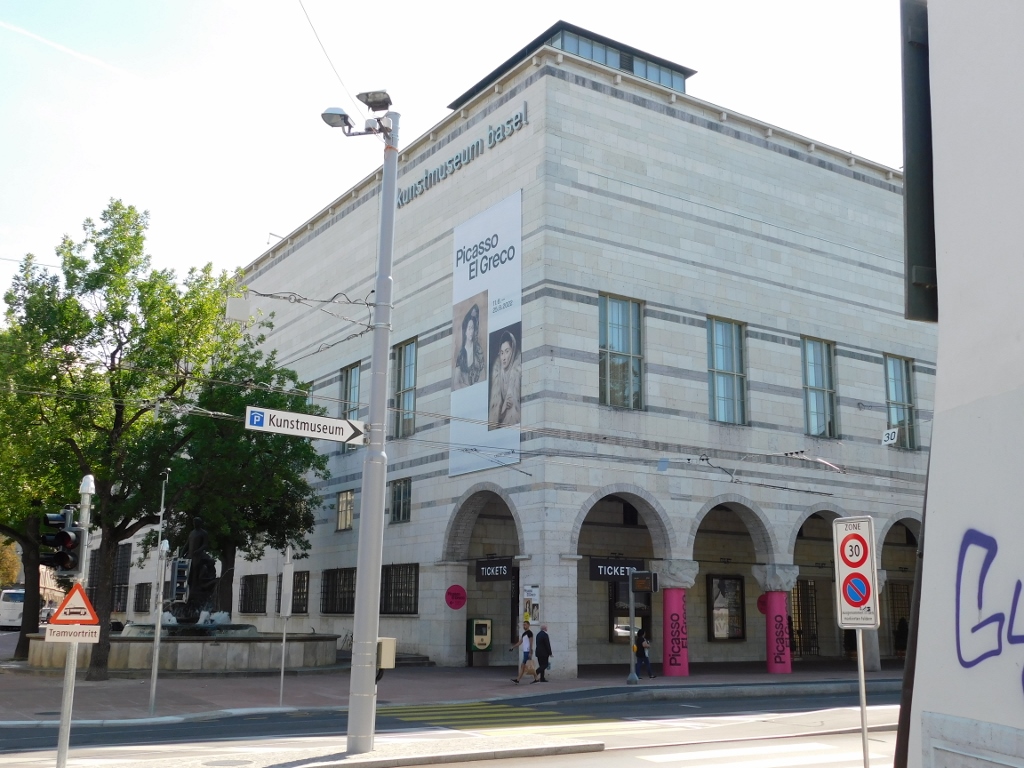 The Fine Arts Museum Basel
The Fine Arts Museum Basel
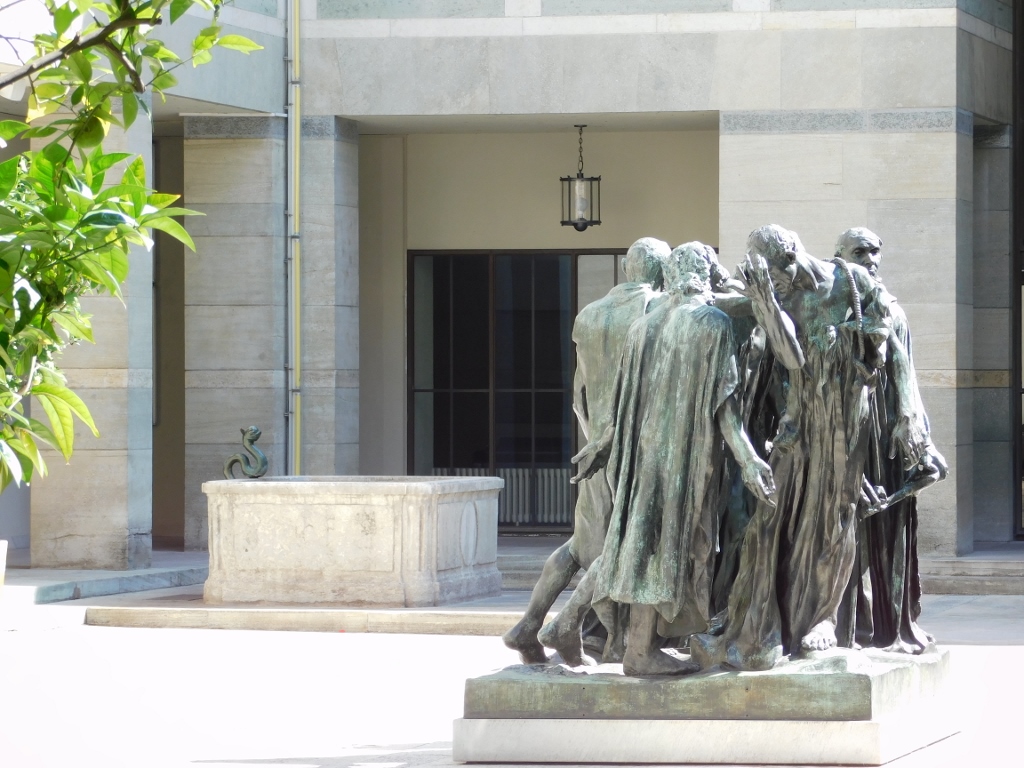 The Fine Arts Museum Basel, a detail
The Fine Arts Museum Basel, a detail
The museum was founded in 1661, although its main edifice was built in the period 1931-1936. It is remarkable that this was the first museum open to public in the world. It has an interesting collection and should certainly be visited, but in my case this will have to wait for some new visit to Basel.
Instead of the museum, I went to a nearby bridge over the Rhine and there I enjoyed a fine view again. On the other side of the river there are parts of Basel that are a mixture of the old and the new, and that was apparent already from the bridge.
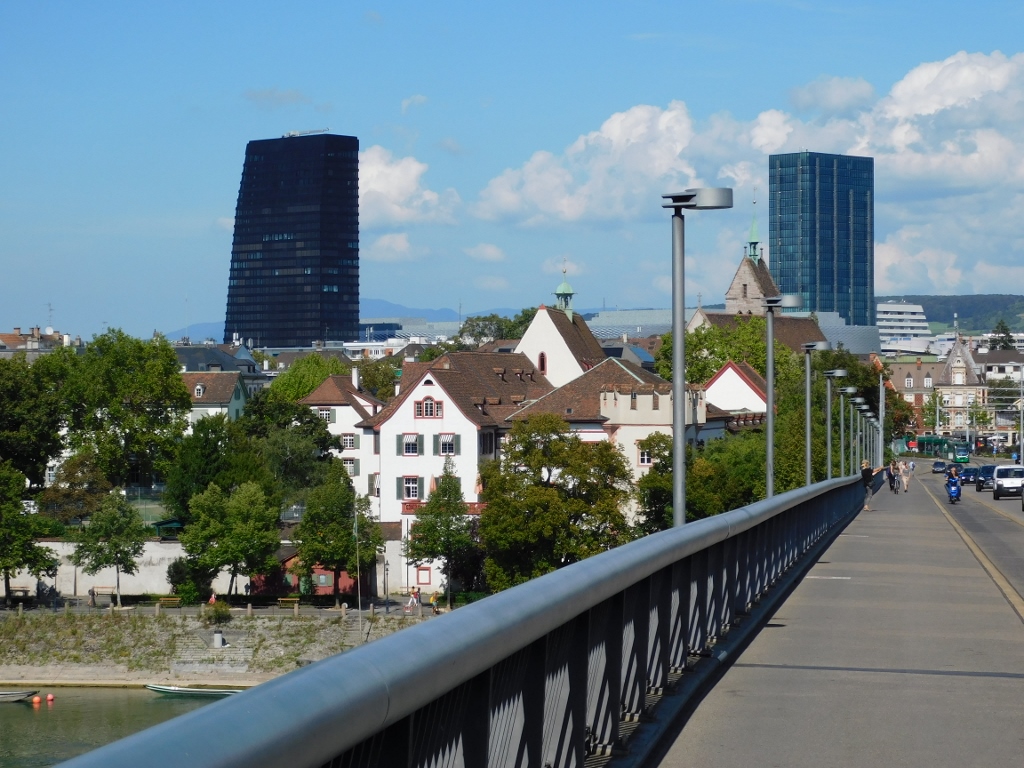 Parts of Basel on the right bank of the Rhine
Parts of Basel on the right bank of the Rhine
 The Rhine in Basel; parts of the Old City may be seen on the left-hand side
The Rhine in Basel; parts of the Old City may be seen on the left-hand side
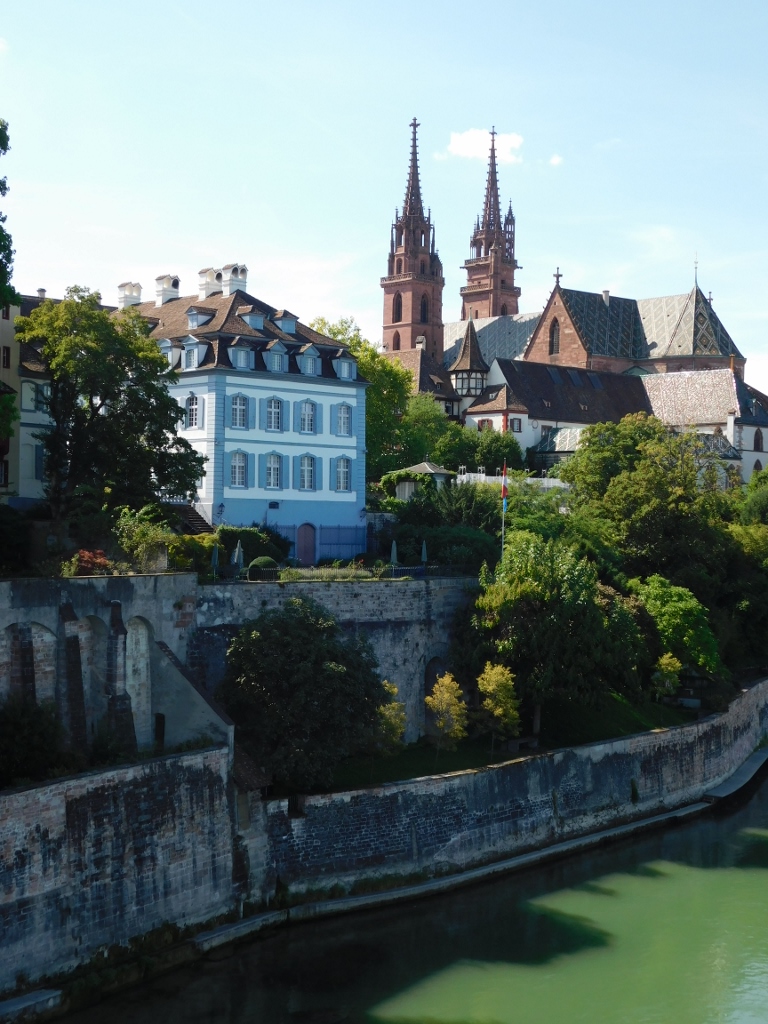 Parts of the Old City in Basel; the towers belong to the Cathedral
Parts of the Old City in Basel; the towers belong to the Cathedral
I did not cross to the other side of the river, although there is a fine promenade over there. To start with, I did not have a lot of time, plus, I had already come up with a nice plan for the visit to the old part of the city. That’s why I returned towards the museum and there I followed a street in the direction of the Cathedral. I liked the houses – although they still had predominantly simple exterior, they were made with some more imagination than those that I had mostly seen in Bern.
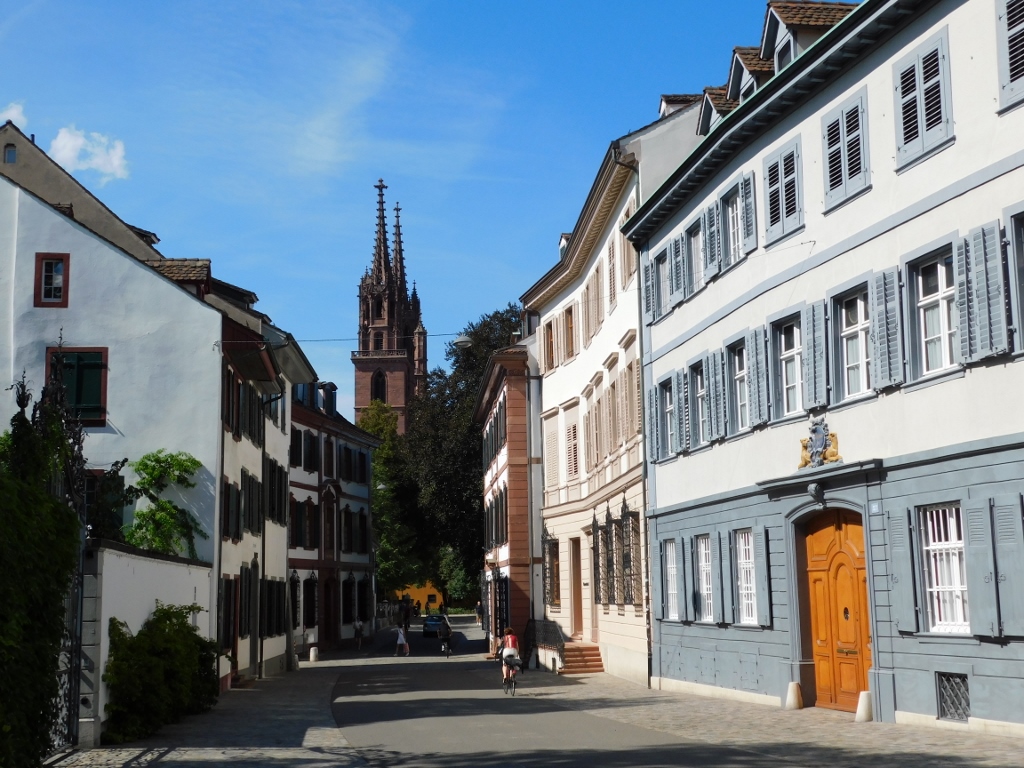 Basel, details
Basel, details
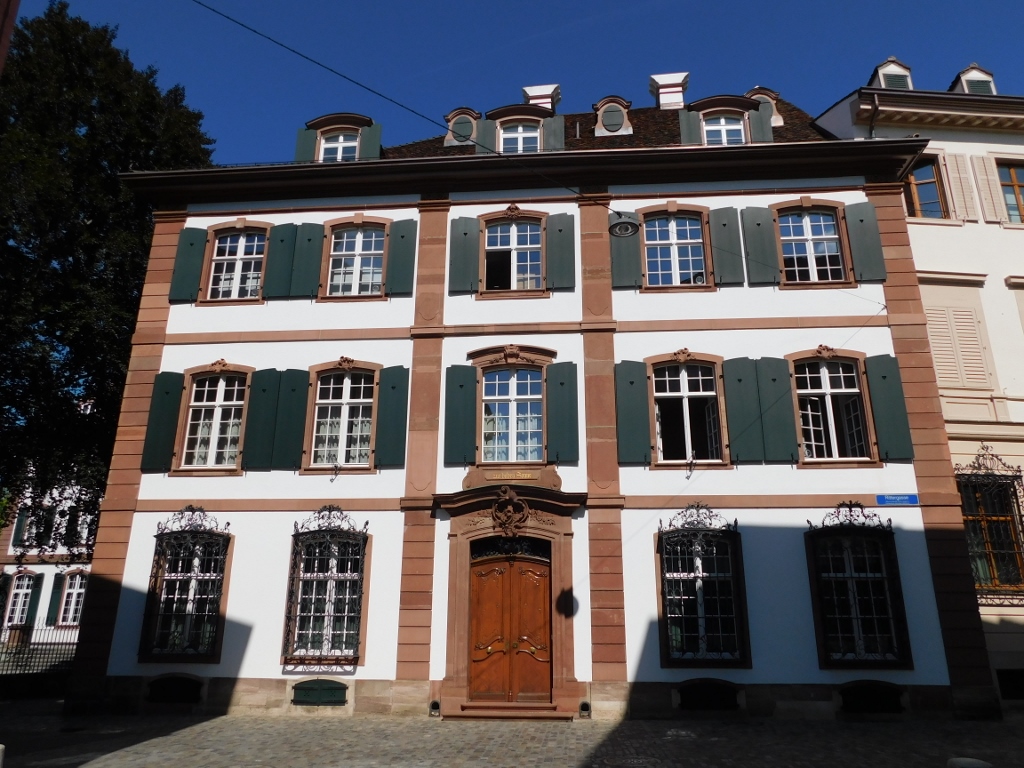 Basel, details
Basel, details
At some point, I noticed a girl in the window of the attic of a picturesque house, we could almost say it was a tower. Was it a young Repunzel? And how did I conclude she was young? Well, because her hair was still short enough and she still had a long way to go before her hair would be down to the ground with a prince coming.
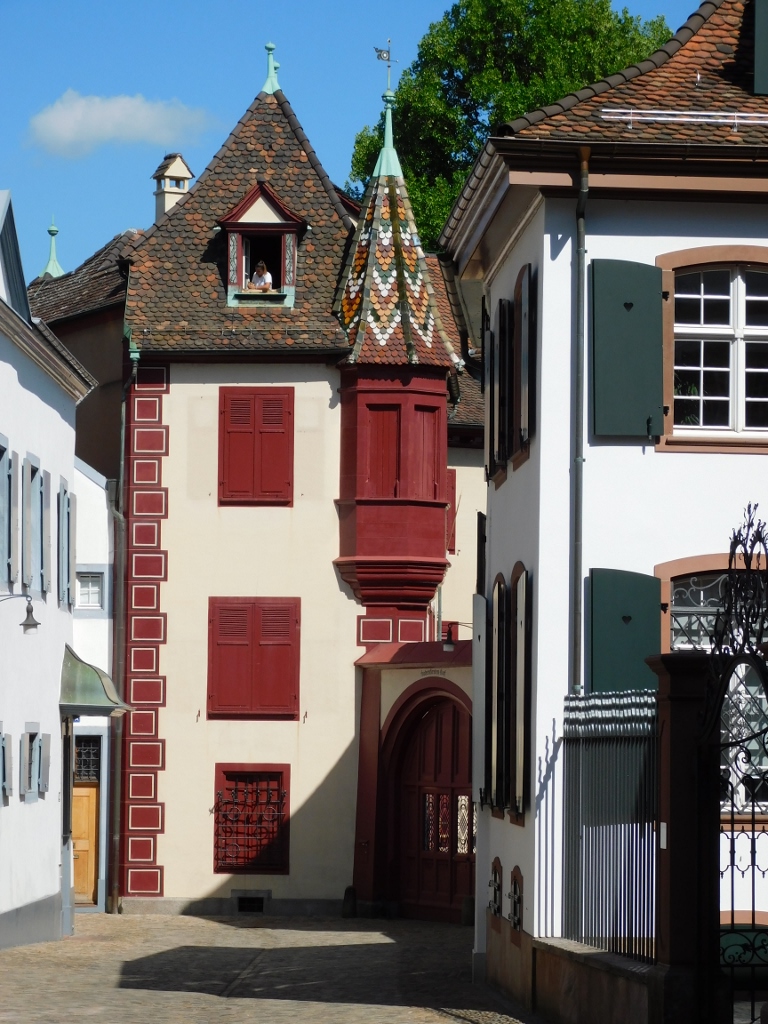 Basel, fairy-tale details
Basel, fairy-tale details
While I was writing these stories back at home, I discovered inadvertently that the house with “Repunzel” seen in the photo above is actually quite famous and has its own name, Hohenfirstenhof, and that it was most probably built in 1356.
Then I went to the Cathedral, but first I entered a section that is flanking the church and that includes two cloisters, the major and the minor ones, from the 15th century. From there you can also see a part of the Cathedral with towers.
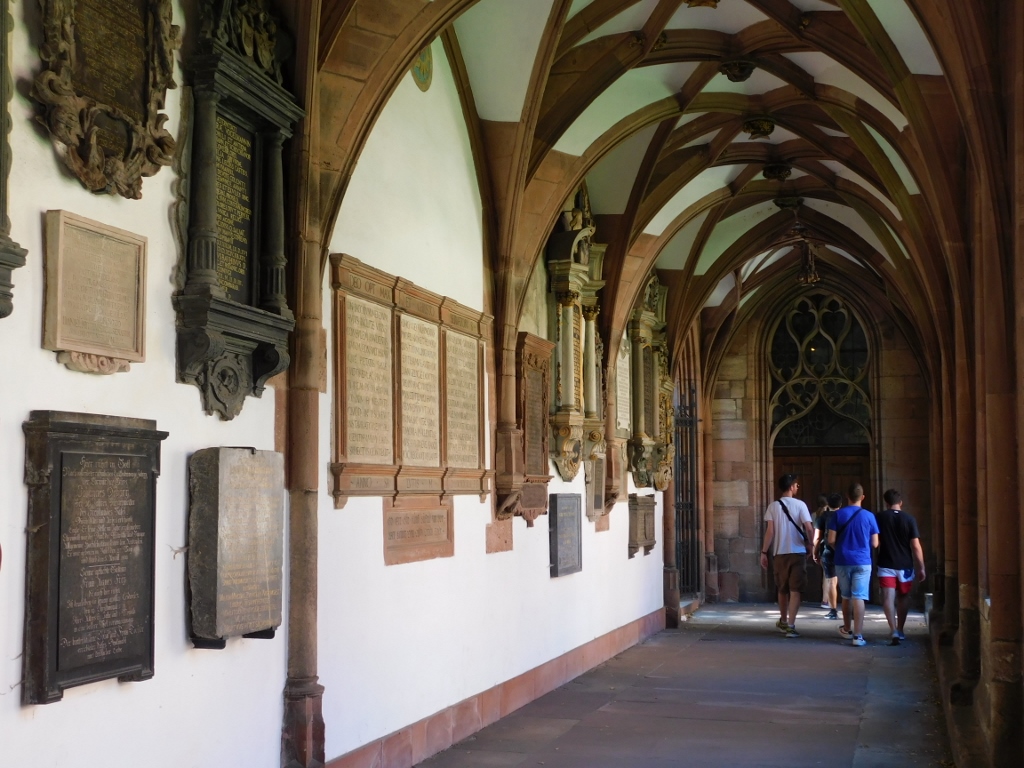 Cloisters adjacent to Basel Cathedral, a detail
Cloisters adjacent to Basel Cathedral, a detail
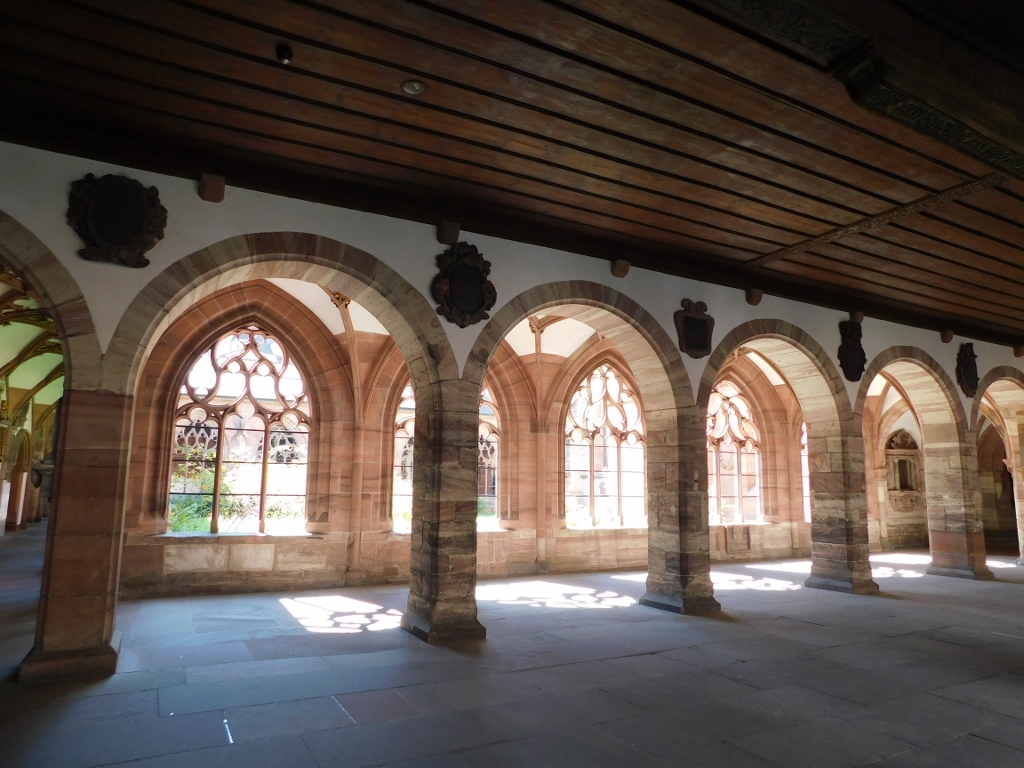 Cloisters adjacent to Basel Cathedral, a detail
Cloisters adjacent to Basel Cathedral, a detail
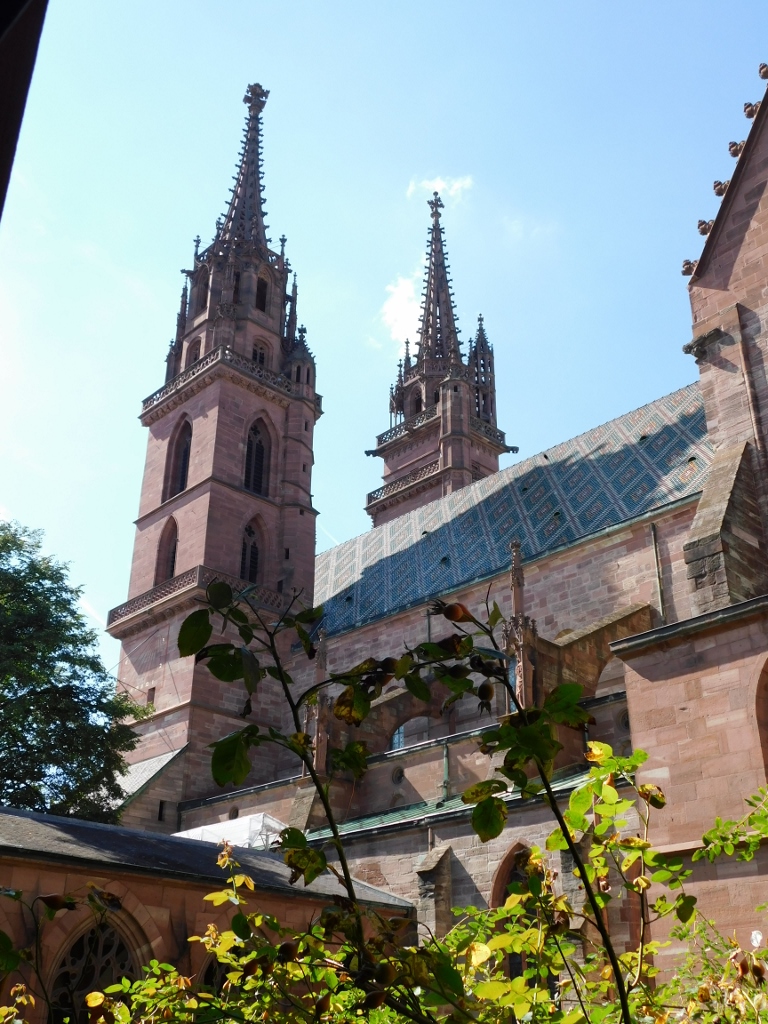 View at the Cathedral from the section with the cloisters
View at the Cathedral from the section with the cloisters
It is advisable to come here and go all the way through this section, since this is one of the ways you can get to a small terrace-park right behind the Cathedral. It is called the Pfalz.
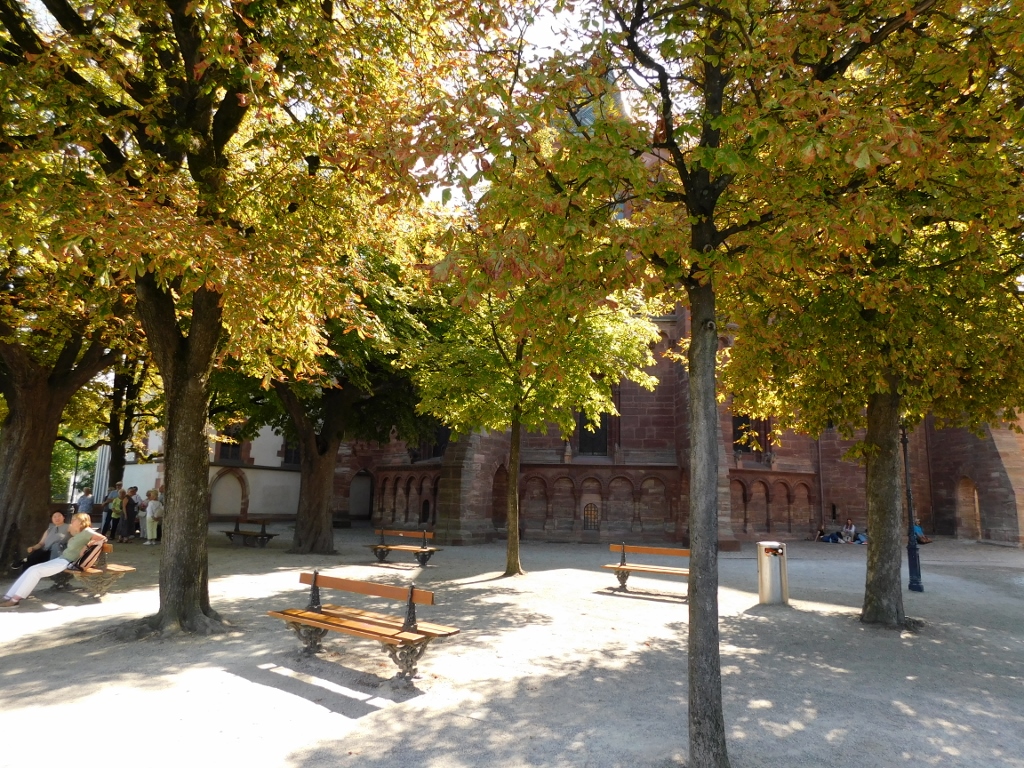 Pfalz
Pfalz
Not only can one rest here while sitting on a bench, but also there is a splendid view at the Rhine and some other parts of Basel.
 View from the Pfalz terrace
View from the Pfalz terrace
Then I returned to the square from which the visitors enter Basler Münster. Something was getting ready in the square on this day, some kind of a stage and chairs for the audience, so the whole place was buzzing with activities and different vehicles.
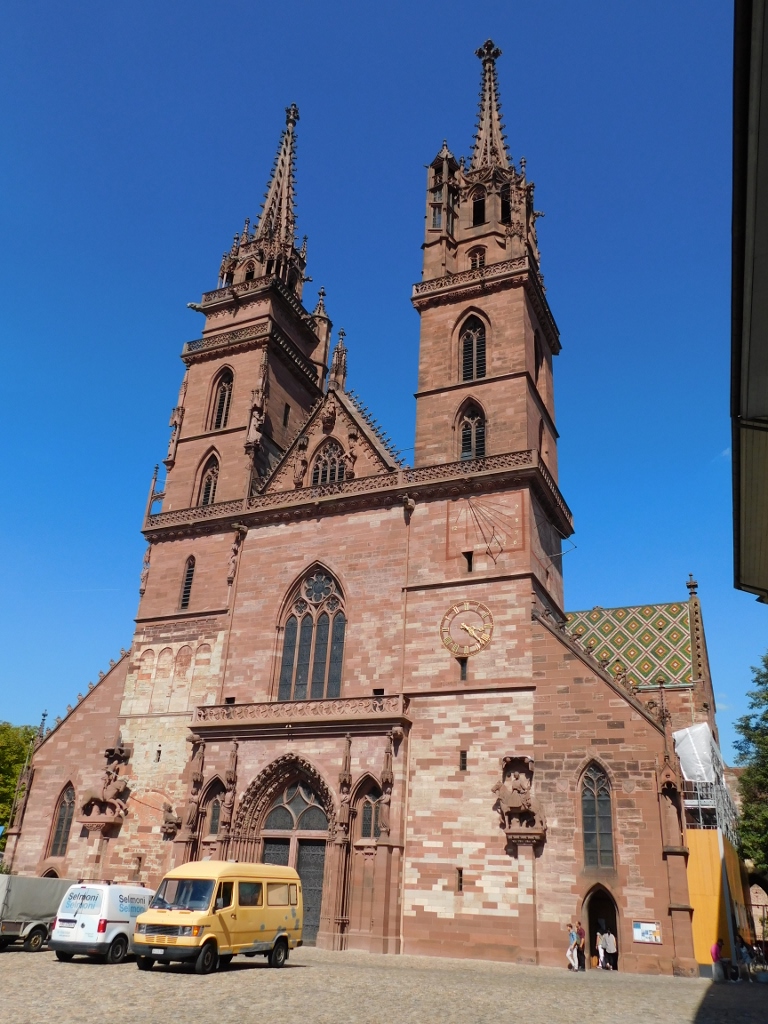 Basel Minster
Basel Minster
The construction of the original cathedral started already in the 11th century and it continued with a restoration (because of an earthquake in 1356) and additions until the 15th century. Particular charm of this edifice comes from the red sandstone that was also used to build the two Gothic-style towers.
In addition, the doorway from the middle of the 13th century with rich decoration is also important.
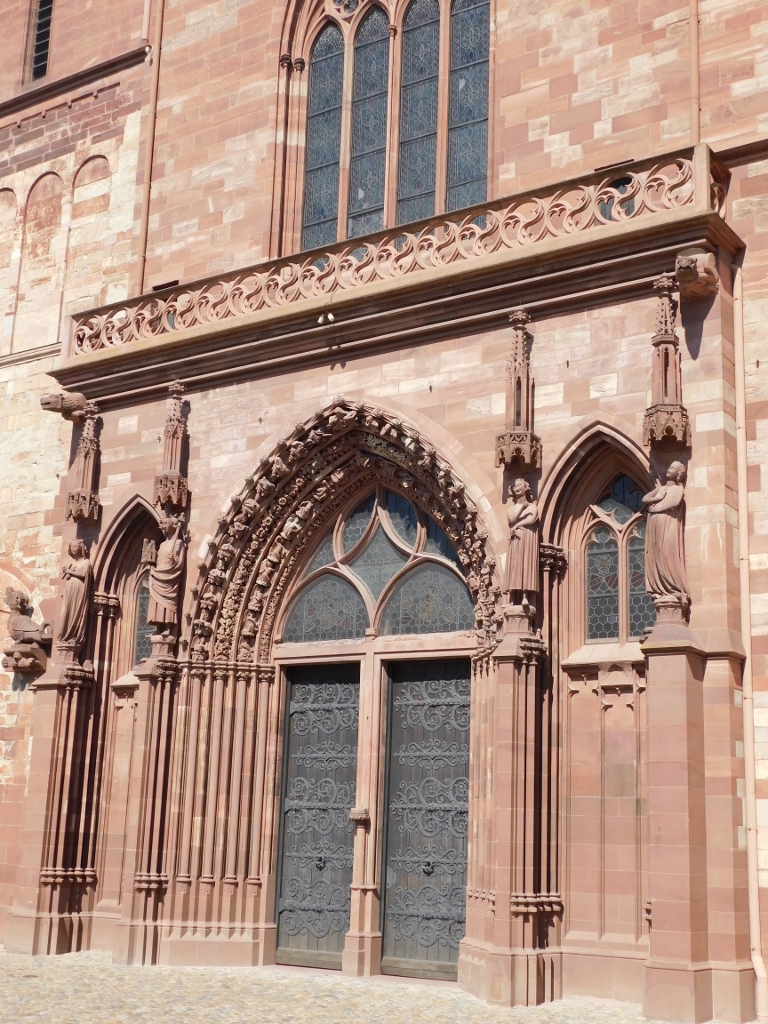 Basel Minster, a detail
Basel Minster, a detail
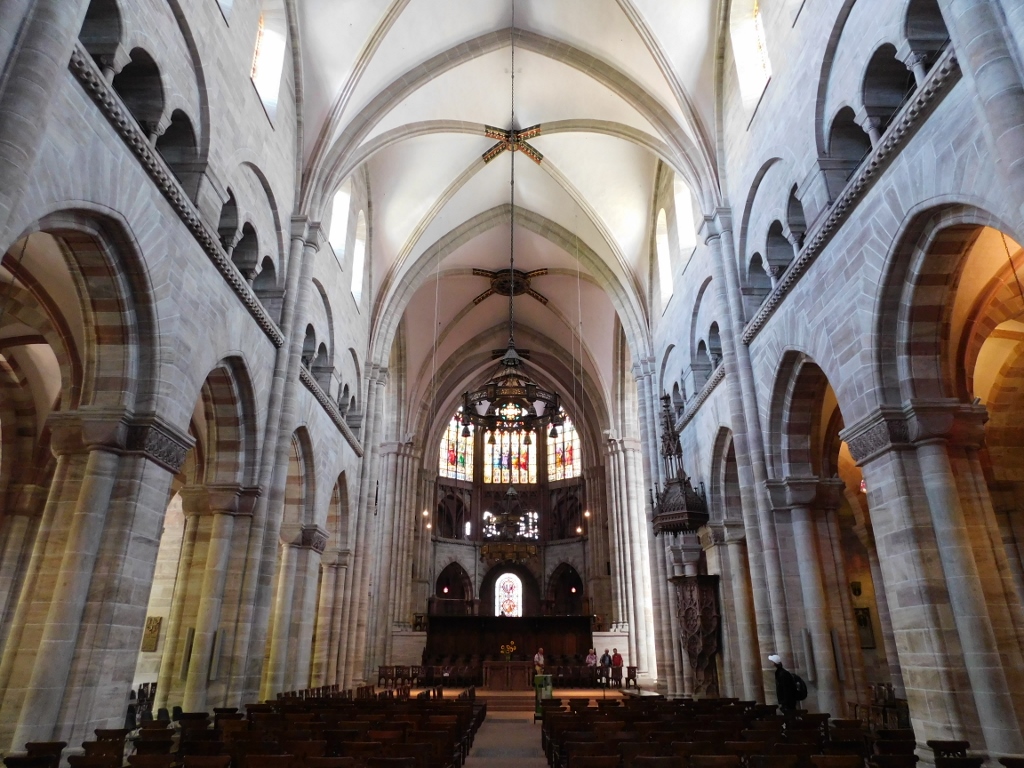 Basel Minster, the interior
Basel Minster, the interior
When you enter the Cathedral it is also interesting to go to the crypt because there you can walk through the underground sections of the cathedral with remains of the old buildings at this site. The research has shown that these sections date back to the period from 820 to 1500 CE.
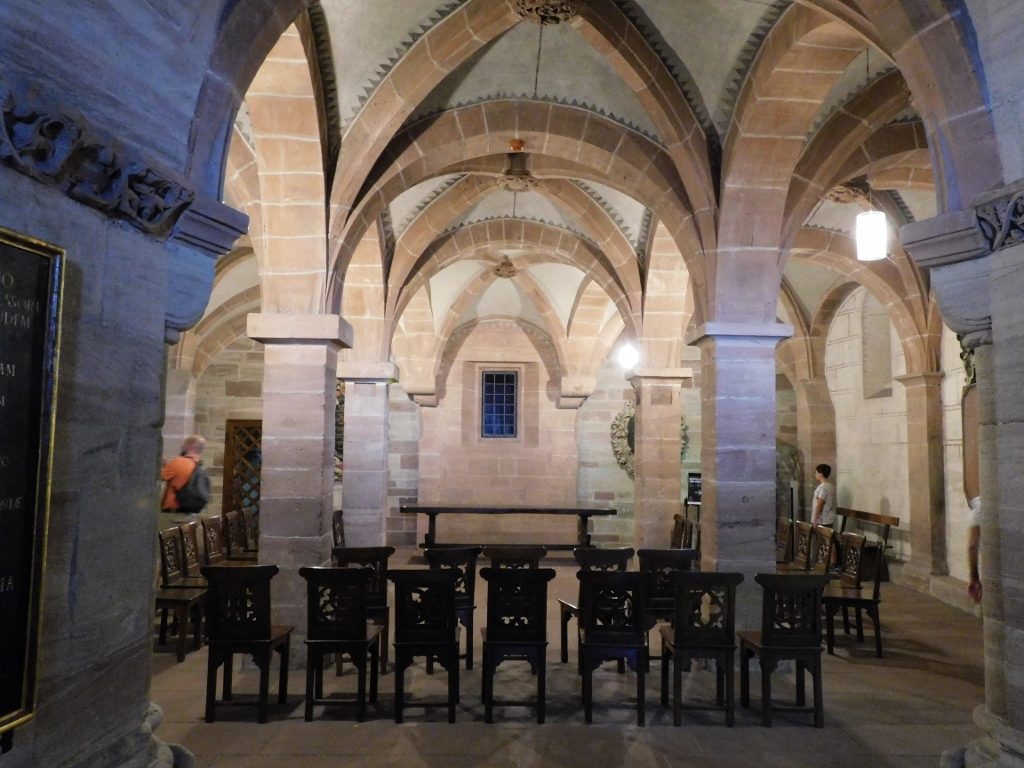 Basel Minster, the crypt
Basel Minster, the crypt
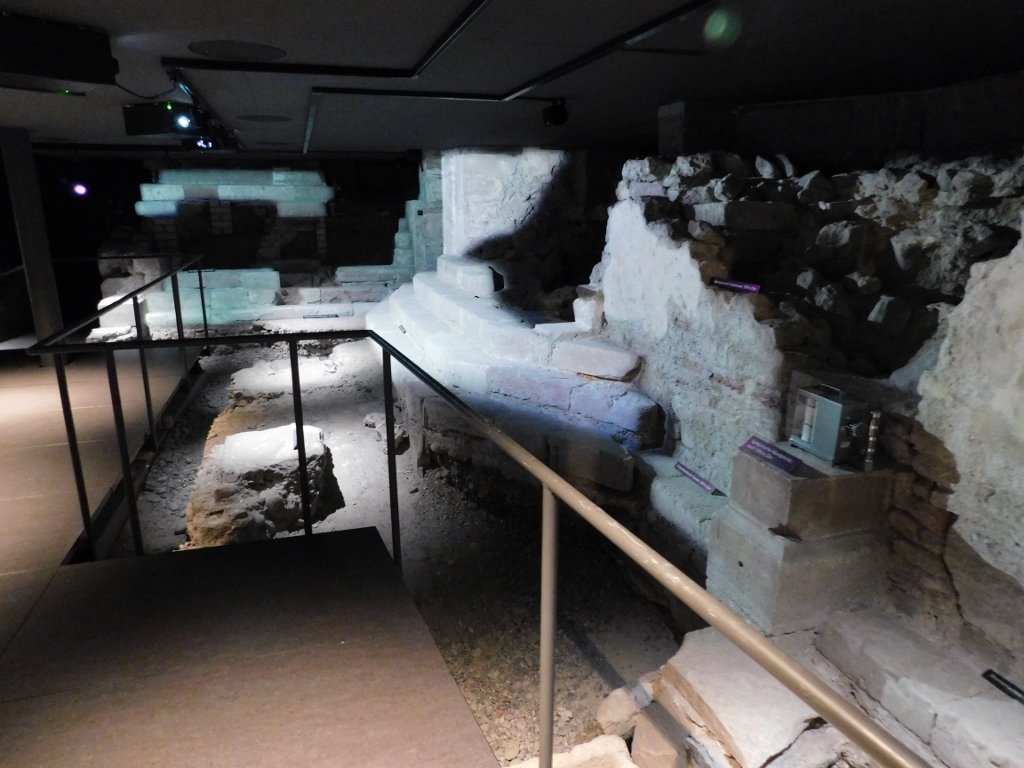 Basel Minster, the remains of older buildings
Basel Minster, the remains of older buildings
Basel Minster is also interesting because this is where the famous Dutch philosopher, theologian and humanist Erasmus of Rotterdam (1466-1536) was buried. I was overwhelmed by the impressions from the crypt and completely forgot to look for this grave. In fact, what can be found here is an epitaph written on a stone slab placed on one of the pillars in the far left nave of the church.
After the visit to the church, I went to an inn across the square in order to sit down a little and get refreshed since it was quite hot and this exhausted me a little. Still, I did not stay there for too long, opting rather to continue with my sightseeing of Basel.